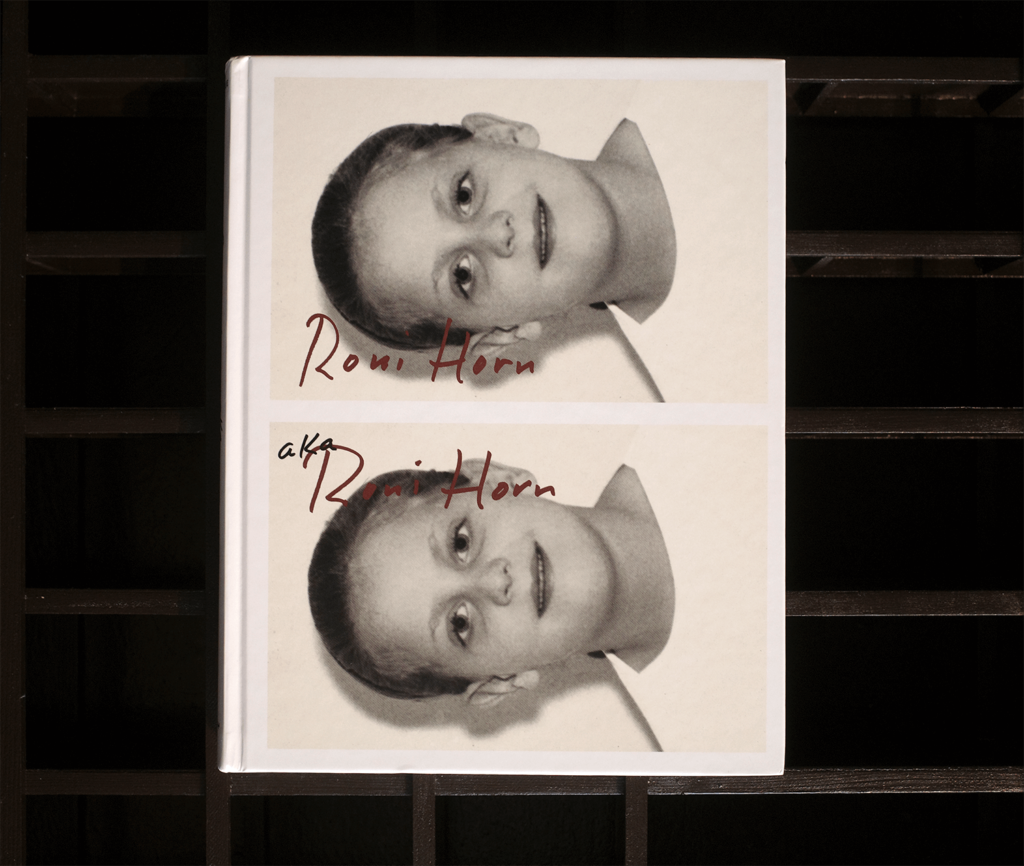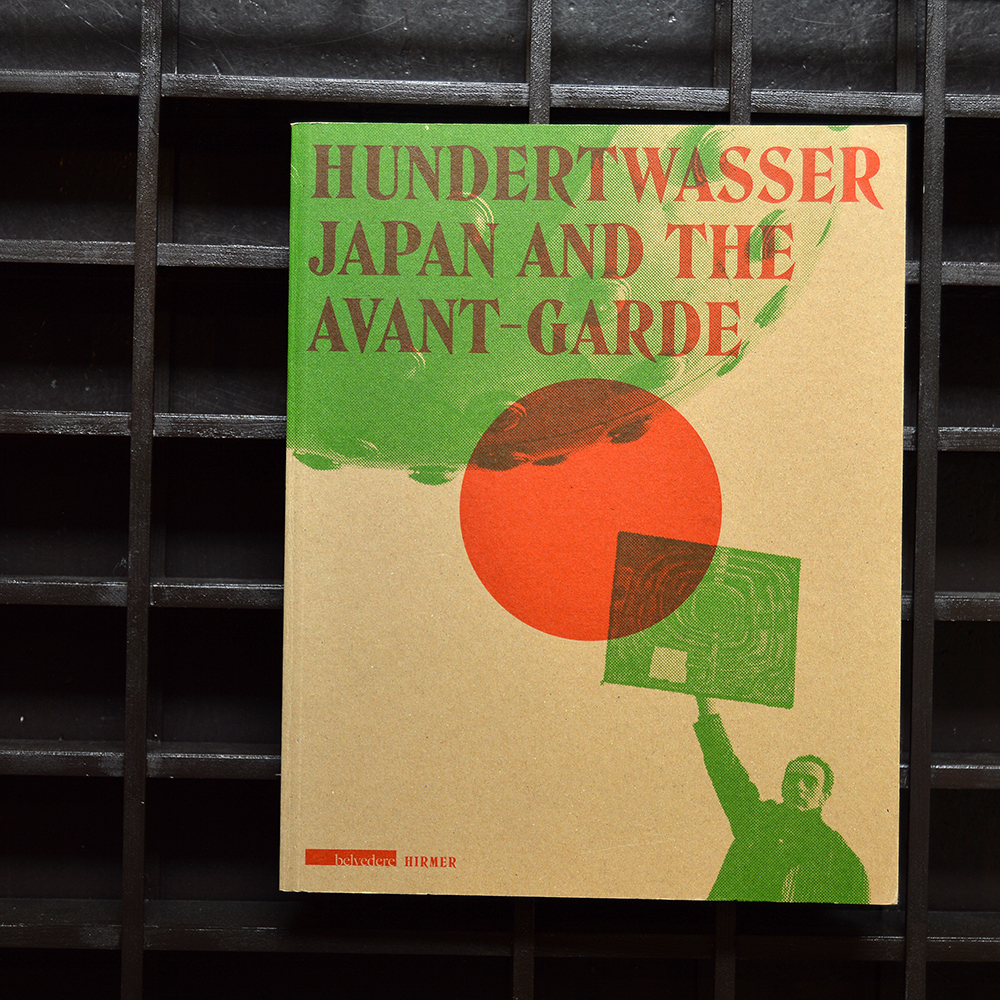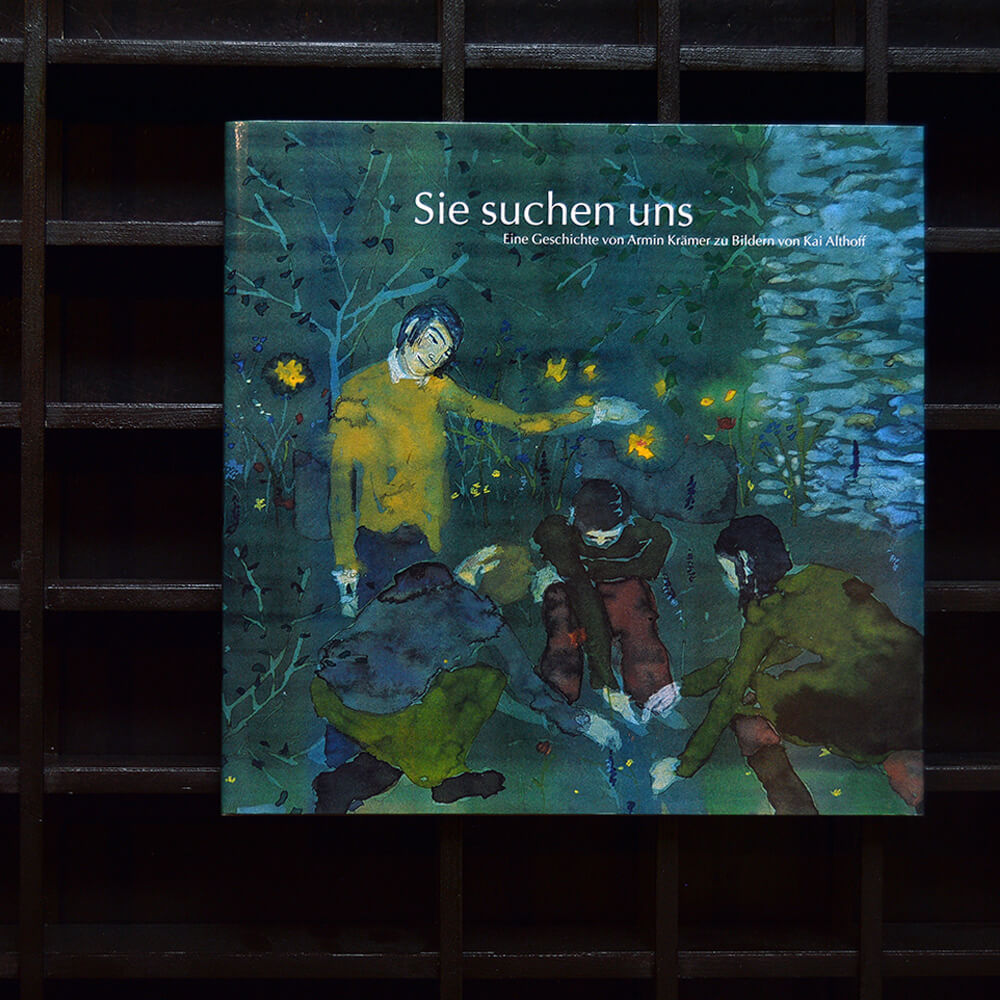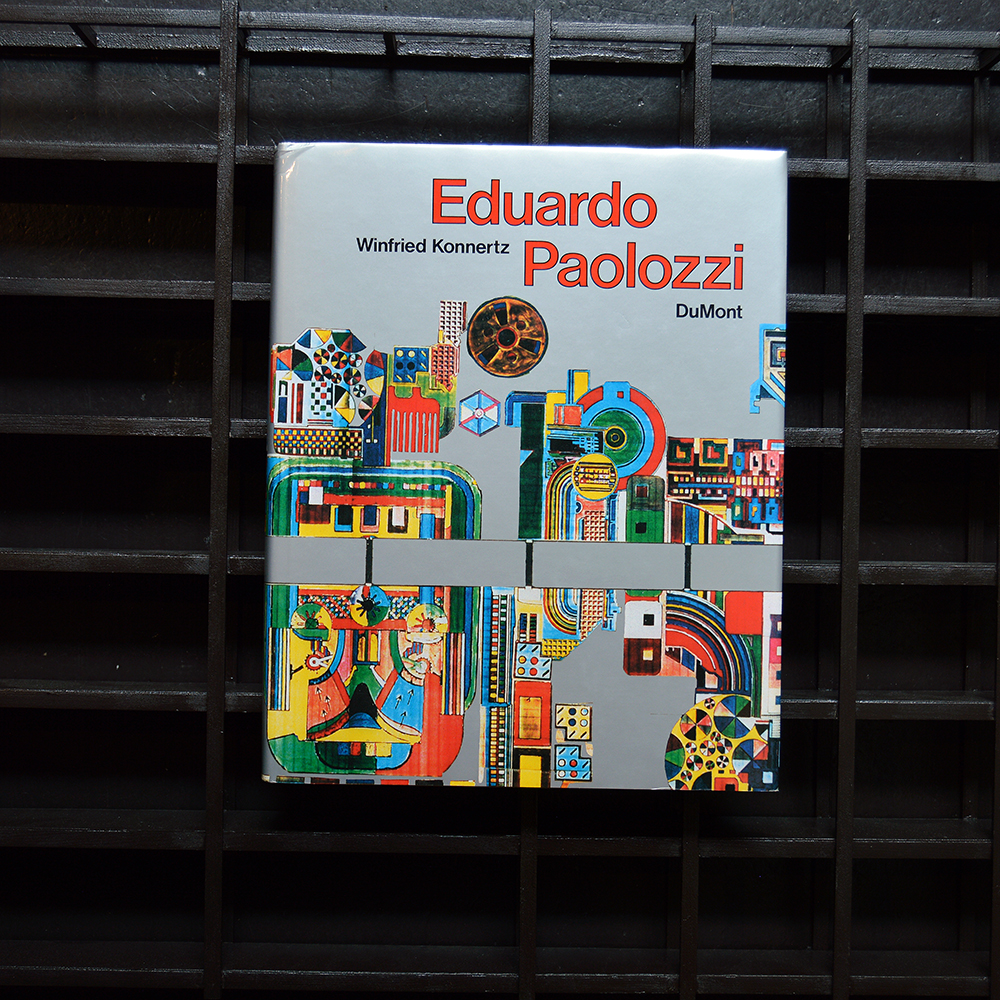** Our bookshop in Berlin-Mitte has closed ** Orders available only via www.bomdiabooks.de **

It was a game of memory, all the cards turned over in no particular succession. And she couldn't recall the rows in which the precious pairs were placed. He landed face up time and again plaguing her with the sensation of having inadvertently laid his useless card in the wrong place on multiple occasions. She needed Silas and Jacob Payne. She needed to find their mirrored faces and stack them on her side of the table. Being identical twins, the Payne Brothers had the talent of being everywhere at once. ↑ ↓ ↓
€35,00

The artist book in fugue, which was produced for the exhibition of the same name at the Kunstverein Hannover, is the first comprehensive publication on the artist Isabel Nuño de Buen. The book develops a parallel narrative to the exhibition by presenting the works through a subjective cataloguing system that corresponds to the central elements of her practice: intuition, improvisation and process-based thinking between drawing, sculpture and installation. Exhibition views are combined with a re-imagination of the works within the space of the book, bringing together photographic reproductions with drawing and colour. The stitch binding technique of the book was specially developed and is partly handmade by the artist. The publication provides a profound insight into the artist’s multi-layered oeuvre, which oscillates between sculpture, installation, and drawing and focuses on a fascinating subjective world of forms and thoughts. ↑ ↓ ↓
€35,00

This publication assembles three phases of Termite Economies, a major series of artworks produced between 2018 – 2020 by the Australian artist Nicholas Mangan. In Termite Economies (Phase 1) Mangan researched an anecdote that termite abilities might one day lead humans to gold deposits. Phase 2 explored termite eusociality, pheromonal communication, building behavior, biomimicry, superorganism and swarm intelligence. Phase 3 deployed termite collectivism as a speculative model for rerouting human neural pathways. Within each phase, Mangan developed specific methods to explore these phenomena formally, spatially, and through moving images. Termite Economies grappled with the potentiality of collective social behavior and complexities of systematic exploitation of non-human intelligence. The book presents each phase in the order of the exhibition series. It includes process and research photographs, diagrams, installation and detailed imagery. It includes an essay by Artist Mariana Silva, a fictional text by writer ST.Lore, a conversation between Mangan and cultural theorist Ana Teixeira Pinto, and a republished essay by Dr. Guy Theraulaz Research Director Member of Team CAB: Collective Animal Behavior Center for Research on Animal Cognition, CNRS. ↑ ↓ ↓
€34,00
SOLD OUT

With a book, an installation in our window space and an outdoor performance series, Claudia Hill presents the travel diary of a handwoven poncho. In her project that spans ten years, the artist challenged the participants to ask the question: What is the most essential element of what you do, and how can it be shared in a significant way? Hill shows this to be an urgent question, locating the value of art in its relational and transformative contingencies. The poncho was passed between artists in different geographic locations during this ten-year period. Every artist, or occasionally someone on their behalf, handed it off to the next participant, and Hill would prompt them: “Do something with this, and then send me something.” The results of these projects will be published in a book with 30 different contributions, released alongside the exhibit. In the book, as well as through the video project on view at Efremidis, Hill evokes a collective consciousness emerging from this garment. Weaving the poncho was the starting point of the piece, and this gesture ultimately became one of care and togetherness. As poet CAConrad exclaims, “I feel the beautiful residual haunting of those who wore it before me!” ↑ ↓ ↓
€26,00

€45,00

Let’s say a blank page is not actually blank. In fact, let’s say it is anything but blank. Devoid of colour, yet infinitely colourful; full of possibilities for multicoloured pens and literally covered by multitudinous life forms. It turns out that even the emptiest page is technically more than full – it’s alive. Do microbes respond to colour on paper? Can spontaneous doodles give rise to new species? Based on Antonie van Leeuwenhoek’s term for microorganisms, this age-fluid book considers a world where the smallest is suddenly in control of the largest. Its illustrations function as an exploration into morphological occurrences, rejecting the goal-oriented, the figurative and the categorical. Following a traditional format, these pages attempt to open up a creative bypass. To draw is to embrace mutational forms, and to colour in these pages is to understand that many possible forms may emerge as a bear or a bacterium. We are what we draw. Time then to let those animalcules express the possible colours of kingdoms to come. ↑ ↓ ↓
€19,00
SOLD OUT

Adrian Williams. The Curve focuses on the sunset, the moment between day and night structuring our days into a before and an after. Our baring witness to the sunset relies on the specific constellation of time and place, events bound to the trajectory of the sun. The book is composed of three reflections on this space of transition as the sun slips beyond our line of sight. The horizon, the line between earth and sky becomes a surface for projection, for form in the absence of it, and although the sun sets every day, its movement familiar and predictable, it is nevertheless spectacular. The Curve is based on a performance of the same name by the U.S. artist Adrian Williams, realized in 2019 with six musicians at Preußenstadion home of the third-division soccer team SC Preußen Münster. At sunset, the stadium became the setting for an acoustic intervention of light and sound. The book extends the performance beyond its original venue with Münster’s Preußenstadion as its starting point. The three authors introduce encounters at dusk from different perspectives and tell stories linked to the course of the sun. Merle Radtke shares memories of sunsets seen and the art historical relationships to the natural spectacle we award them. From a rooftop in Washington, D.C., Matthathias Schwartz reenacts The Curve, listening to recordings from the stadium in Münster, at another place and time. Adrian Williams writes through the piece of the piece, voicing a possibility for the work’s intent. These three texts are wound between Williams’ photographs of sunsets at dusk: light on clouds, a reflection in a window, the glow behind a mountain. These images are always evidence of an instance recorded, of having been present at a time and place, for the meeting of the sun at the horizon. ↑ ↓ ↓
€21,00

Conceived in close collaboration with Shimabuku as an extension of his exhibition The 165-metre Mermaid and Other Stories at Villa Paloma in 2021, this new publication tells of the poetic actions conducted during his travels, between his native Japan and Monaco via Brazil, Australia, and many other lands. The artist’s texts form the narrative thread of a subsequent ensemble of installations, films, sculptures and photographs made over the last thirty years. Three essays never published before have been written for the occasion by art critics and curators Nicolas Bourriaud and Claire Le Restif as well artist Rirkrit Tiravanija. As an introduction, Célia Bernasconi, curator of the exhibition, traces Shimabuku’s artistic adventures through a logbook, therefore, confronting the epidemic context. Through the logbook, she reviews productions made by Shimabuku in Monaco in 2021, amongst which the totemic work Erect is featured on the cover of the book. ↑ ↓ ↓
€39,00

The circus is a drama that extends its own means, and the metaphor of its name (itself clowning around with the word) is widespread across the art industry, financial world, and, of course, anything to do with performance. For four years during the mid-aughts, photographer, video and film artist Ieva Epnere immersed herself in the life of the Riga Circus – a type of traditional circus that cherishes the respectful use of animals, operating on a circus-family model (skills are passed down through generations to produce family units that travel and live on the road), and the big top tent (the landmark interior of one of the oldest circus structures, built for this purpose in Europe since 1888) as a performance space. This publication, that was developed during Ieva Epnere’s fellowship with the Artists-in-Berlin Program of the DAAD, symbolically marks four stages of her single, larger work. Fine-tuned digital color shots, a collection of black-and-white 35 mm film prints showing action at the Riga Circus, followed by a burst of color shots and black and white photos taken on a film camera, to end with a set of intimate black-and-white portraits of the performers. Whereas the conversion of circus into text might to some degree be a violation of the true nature of its subject, Ieva Epnere’s book – with the help of elephants, clowns, all the “freakery,” and her kaleidoscopic peek into the machinery that makes performances in the arena possible – itself stands as an adventurous act of reinvention. ↑ ↓ ↓
€27,00

Window / Spacetime is a portrait of the city of Berlin. A variety of shops that have names of countries and cities refer to different faraway places and invite the reader on an imaginary journey. Dis- and misplacing distant memories of the past triggers a yearning sense of other destinations within the everyday scenarios. The publication succeeds a video work with the same title which was shown at the exhibition Drift and Shift in Kunstverein Göttingen in 2018. ↑ ↓ ↓
€16,00

A companion catalogue for Kai Althoff’s intimate and enduring exhibition of new paintings and works on paper presented at TRAMPS New York October 2018 - January 2019 with text contributions from DovBer Naiditch, Ansgar Murr and Hanayo Nakajima. Kai Althoff is widely considered to be one of the most influential contemporary artists of his time. Painting and drawing play a central role in his diverse and very personal practice that also includes music, film/video, performance and sculpture. ↑ ↓ ↓
€28,00

Published together with the CAPC musée d'art contemporain de Bordeaux, this reference book and catalogue raisonné surveys the history of the independent publishing house Beau Geste Press (BGP) through the books published by its founding members Felipe Ehrenberg, Martha Hellion and David Mayor from 1971 to 1976. ↑ ↓ ↓
€39,00

The Long Road to Xico, 1991–2015 is the first monograph of Brazilian artist Maria Thereza Alves, and the outcome of her solo show at the Centro Andaluz de Arte Contemporáneo in Seville in 2015. It gathers more than twenty projects realized between 1991 and 2015, including rarely viewed early works that help us see her most recent production from a new perspective. This publication also collects a selection of Alves’s writings and contextualizes her work in the political and cultural debates from the 1980s, when she became an activist—in the United States and Brazil—and an early participant in discourses around “postcolonialism” and “ecology.” Together with these materials, the book contains essays by the editor, Pedro de Llano, and T. J. Demos, professor of art and visual culture at the University of California, Santa Cruz, and author of Decolonizing Nature: Contemporary Art and the Politics of Ecology (2016). Containing an exhibition history and bibliography with a record of Alves’s activities in art, literature, and politics since the late 1970s as well, The Long Road to Xico, 1991–2015 establishes itself as the main publication on the artist’s work to date. ↑ ↓ ↓
€20,00
SOLD OUT

€28,00

Das Keramikos-Buch zeigt photographische Aufnahmen von insgesamt 300 bemalten Stücken, die die Künstler Matthew Lutz-Kinoy und Natsuko Uchino seit 2010 geschaffen haben - darunter Teller, Schalen und Krüge. Einige Objekte werden von narrativen Beschreibungen begleitet, die die Vorstellungen von Gesellschaft, Religion, Politik, Stil und Technik durch die lange Geschichte der keramischen Produktion aus der hispano-moresken, byzantinischen, islamischen und koreanischen Keramik aufgreifen. Jede Platte ist auf der Recto-Seite gedruckt, ihre Rückseite ist in der gleichen Position auf der Verso-Seite derselben Seite abgebildet. Ein umfangreicher Index rundet das Buch ab. ***** The Keramikos book presents front-and-back photographic records of 300 painted pieces that artists Matthew Lutz-Kinoy and Natsuko Uchino produced since 2010 - including plates, bowls, pitchers and oil jars. Some objects are accompanied by narrative descriptions that present aspects of the duo's vast and complex research exploring notions of society, religion, politics, style and technique through the long history of ceramic production motifs from Hispano-Moresque, Byzantine, Islamic and Korean ceramics. Each plate is printed on the recto side with its reverse shown in the same position on the verso side of the same page. An extensive index completes the book as well as an interview with the artist and curator Nicolas Trembley. ↑ ↓ ↓
€29,80
SOLD OUT

In 2011, the Contemporary Art Club (CAC) in cooperation with the Kunsthistorisches Museum Wien (KHM, Museum of Fine Arts Vienna), organised an exhibition series at the Theseustemple, a classicist building constructed at the beginning of the 19th century in Vienna’s Volksgarten. The project was launched with an exhibition by Andy Hope 1930, followed by Kitty Kraus and André Butzer. The series concluded with a dialogue between Lucy McKenzie and Ian Hamilton Finley, a complex and diverse group of young contemporary artists. This publication aims at documenting this experiment. Accordingly, also the concept to this exhibition series, the basis for the discussion initiated by CAC with the participants, will be published. ↑ ↓ ↓
€26,00
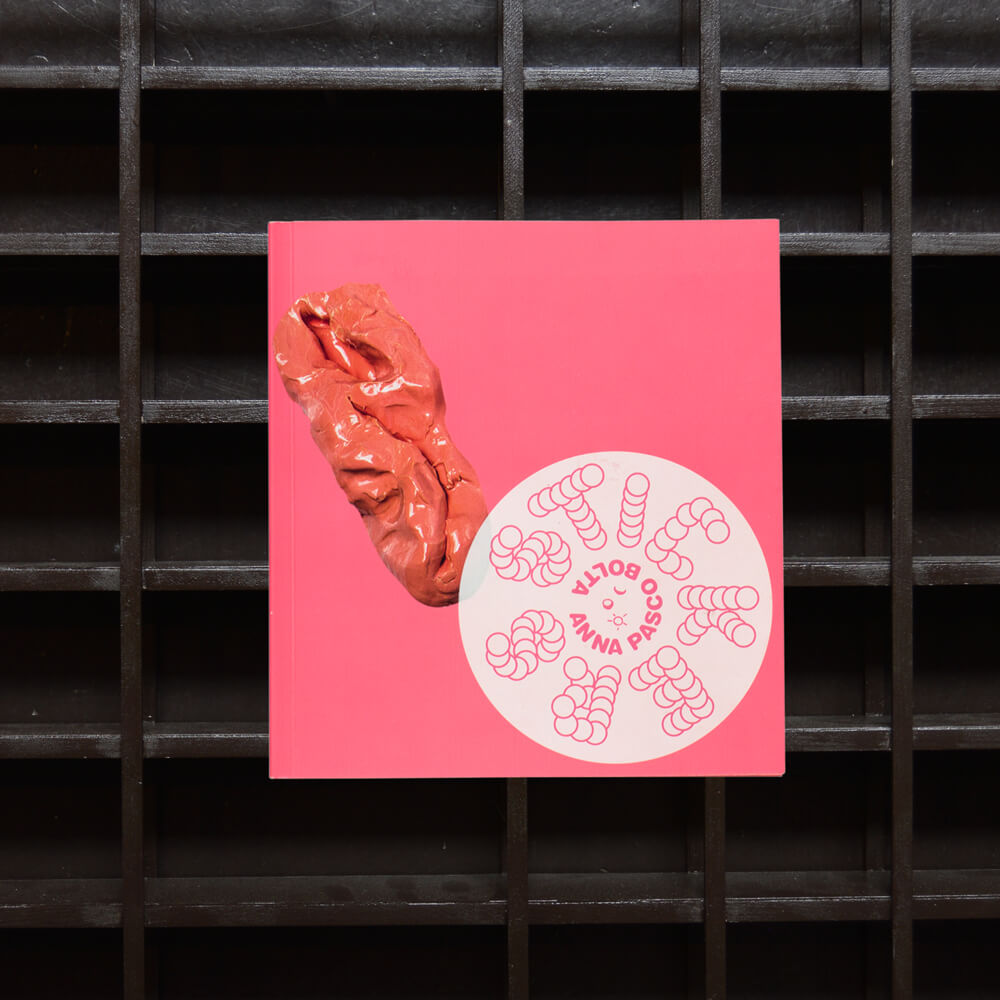
Stickers presents itself as a genre of artist books on its own. The book demonstrates Anna M. Pasco Bolta’s works, including various techniques, within the genre of stickers, and explores the idea how objects can exist in two states: as objects themselves, and as their images. Every copy of the edition is unique and overflowing with stickers waiting to be stuck on. The stickers act as a medium for displaying all content: artwork, text, sponsor logos, ISBN and barcodes, giving a certain autonomy to the images. Thus, Stickers is a changing and pluralistic platform that allows an approach from the audiences individual point of view to Pasco’s work and emphasizes the importance of action and interaction for the perception of reality. ↑ ↓ ↓
€21,00

Sandra Mujinga’s recent exhibition at Bergen Kunsthall presented a large-scale video installation together with a selection of sculptural works and photographs. Drawing on Afro-futurist strategies, the exhibition investigated concepts of invisibility as survival strategies, both as a speculative gaze at the future and in relation to the political reality of our time. The exhibition was Mujinga’s largest solo-presentation to date and will also be on view at Vleeshal, Middelburg, 20.9 – 13.12.2020. This book includes a specially produced visual essay, conceived as an animation in book form. The images are stills from footage captured of an elephant outside of Johannesburg, digitally treated and presented as a series of close-ups of the elephant’s skin. The publication features contributions by Sandra Mujinga, Wong Bing Hao, Tamar Clarke-Brown, Olamiju Fajemisin and Jessica Lauren Elizabeth Taylor and has been has been designed by Studio Manuel Raeder. Published by BOM DIA BOA TARDE BOA NOITE, Bergen Kunsthall and Vleeshal. ↑ ↓ ↓
€26,00
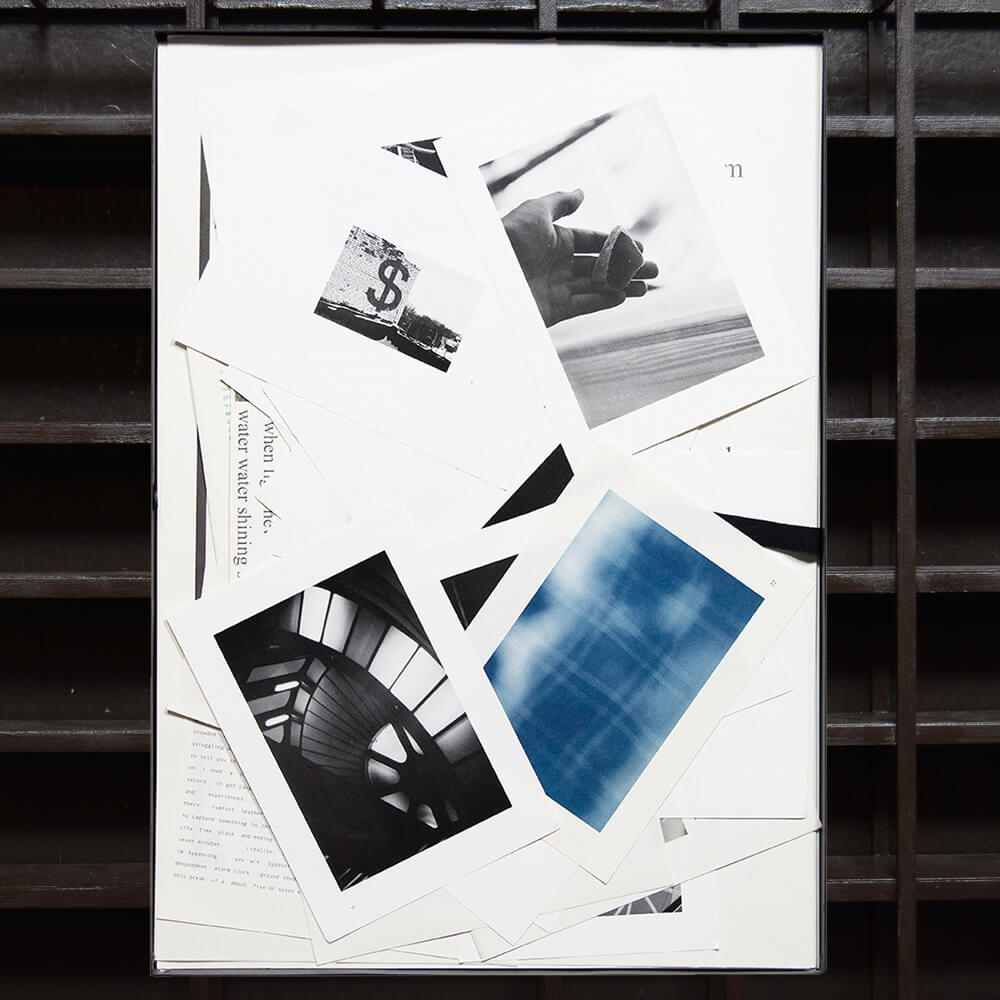
The box set publication No more racing in circles – just pacing within lines of a rectangle is Tris Vonna-Michell’s reflection on the impact of performing several narrations during a concentrated timespan over a number of years. The package contains forty-four sheets printed on a Heidelberg offset press, while the accompanying colophon introduces each sheet in the box set; together they represent the performative aspect of Vonna-Michell´s practice in the form of score and transcription. No more racing in circles – just pacing within lines of a rectangle addresses several time markers in Vonna-Michell’s practice as well as the durational aspect of writing and performing. Limited edition artist’s box set of 200 copies containing forty-four loose pages ↑ ↓ ↓
€90,00
SOLD OUT
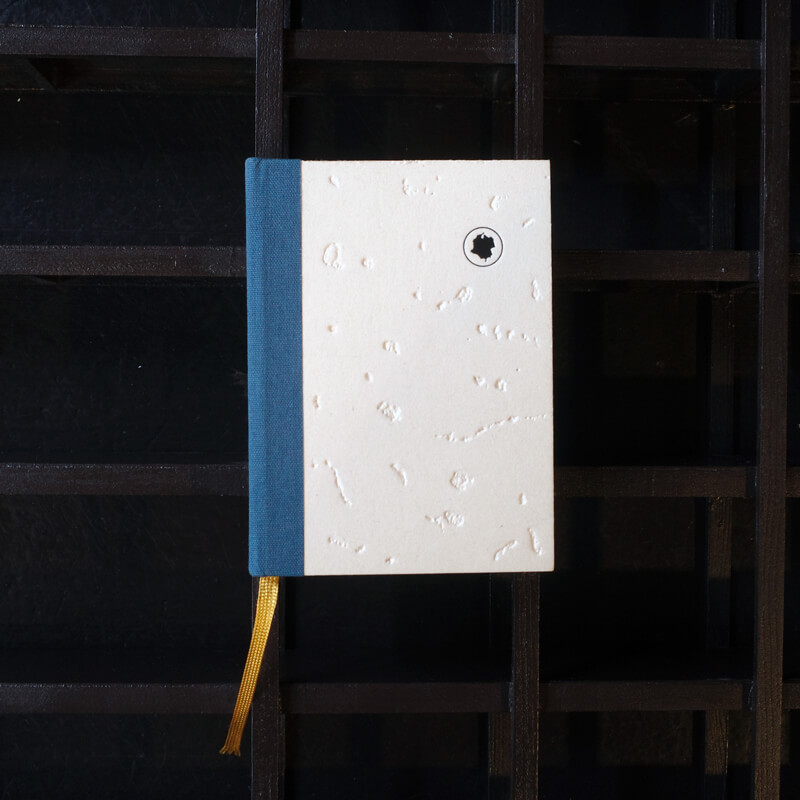
DISCULPE. On bus travel, the cycle of gifting and counter-gifting and a quest for meaning. During their performances travelling on the city busses of Medellín and Bogotá, the hawkers locally known as “vendedores ambulantes” dish out compliments and pleasantries to their audience, as well as excessive apologies and gratitude. As these busses are flagged down by prospective travellers along the route, they face the crowd with all of their spectators already conveniently seated in front-facing rows. The vendors practice something that may be loosely described as “rebusque”, or “the quest for what makes a life”. What this boils down to is making money with whatever is readily available: chocolate bars, ballpoint pens, music or stories. The German-Colombian artist Jan Lotter Benavides has collected 65 such scenes in his unpretentiously laid out, heartfelt small-format book. Titled DISCULPE, it revolves around his clear and knowledgeable transcripts of recordings he made secretly while in Colombia on a travel scholarship from Hessische Kulturstiftung, the Cultural Foundation of the State of Hesse (Germany). It quickly becomes clear that the “vendedores” provide more than just a show, and that the audience gives them more than just small change; in fact, it is about much more than surplus value. In the ethos becoming apparent here we begin to witness a cycle of gifting and counter-gifting that marks the entire practice out as an act of existence rather than one of subsistence. Life is remembered, imagined and narrated as something that is by necessity shared. The bus is then turned into a theatre of a common symbolic space, and it is on this stage that something akin to catharsis becomes possible. ↑ ↓ ↓
€21,00

In the 1970s, José Ortega (alias Morelos) and his brother began traveling from their home in the Peñón de los Baños neighbourhood of Mexico City to Colombia with hopes of finding cumbia records and bringing them back to Mexico. Driven by their passion for tropical music and small outdoor sound systems, in junction with their adventurous spirit, they visited Colombia and other regions of Central and South America. There they found records that would be useful to the owners of the sound systems – the sonideros – in Mexico. Two years ago, Morelos invited Mirjam Wirz and Carlos Icaza, a Mexican musician and investigator, to join him and document his travels. On three separate trips, they retraced Morelos’ route, recollections, and personal connections. With Morelos, the hub and anchor of this story, they worked to discover the origins of cumbia and the sonidero movement throughout Mexico. Ojos Suaves/Soft Eyes is the result of these trips and a sample of relevant material: photographs, transcriptions of talks with various key figures, and some documents from their private collections. ↑ ↓ ↓
€33,00
SOLD OUT
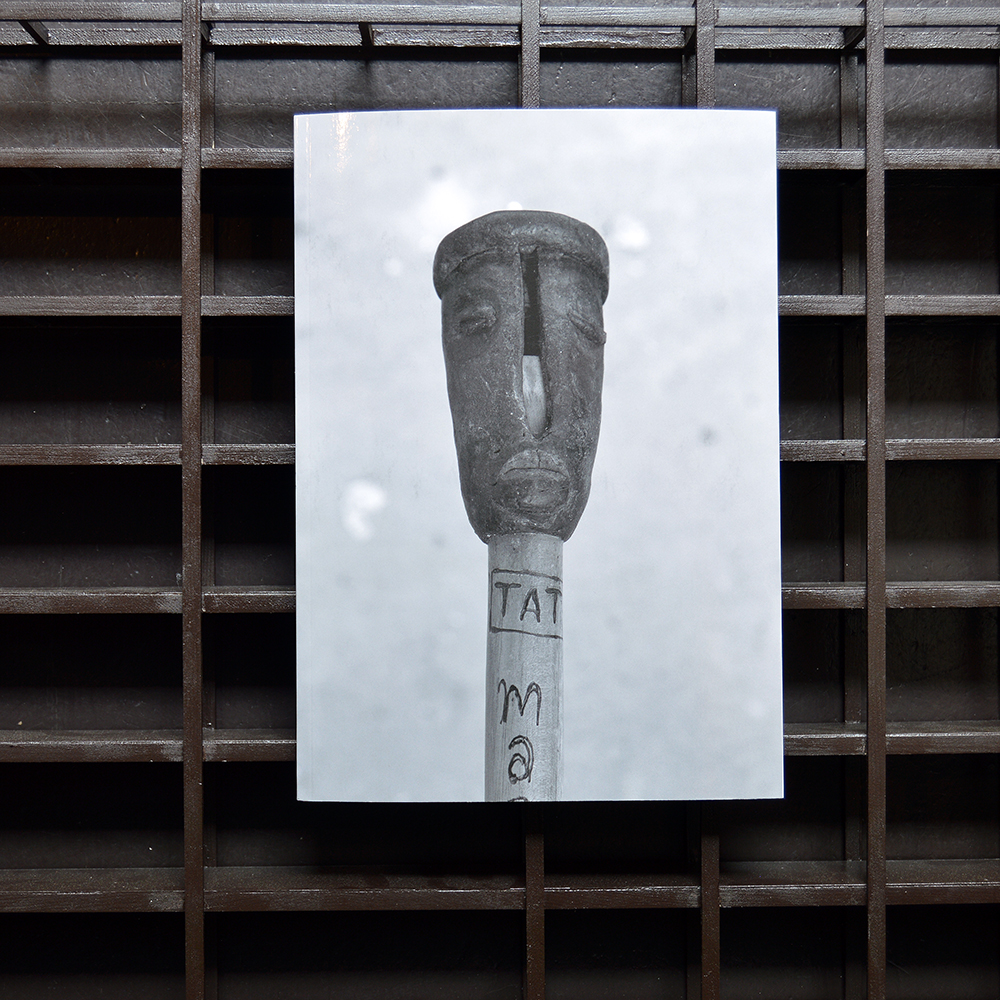
SOBRE EL RÍO (PASSAGE) – tells of a journey along the lower Magdalena river in Colombia in search of the origins of cumbia music – and it is the sixth volume in an onging publication series about cumbia music and sound systems in Latin America edited by the Swiss artist Mirjam Wirz. The books contains photographs, extracts of conversations with musicians, composers and people connected to the river, and poetic texts written after the journey, remembering encounters, situations and landscapes. The Magdalena river marks the birthplace and distribution system for cumbia music, which in its beginnings, dating back to the colonial era, was a prohibited ritual dance and one of the ways in which the indigenous and African populations interacted. Musically, it is made up of a combination of African rhythms, indigenous instruments, and Spanish lyrics. Since the 1950s cumbia has spread beyond Colombia to the working class neighborhoods in Latin America, taking on local specifics at each place. The Magdalena river stands for one of the many rivers in the world which acted as distribution channels and spread music throughout countries – and of water cultures, located along the rivers, which have absorbed very different influences from the interior of the country and from the world, making them multifaceted and thoroughly mixed, which is evident in the music as well. ↑ ↓ ↓
€36,00
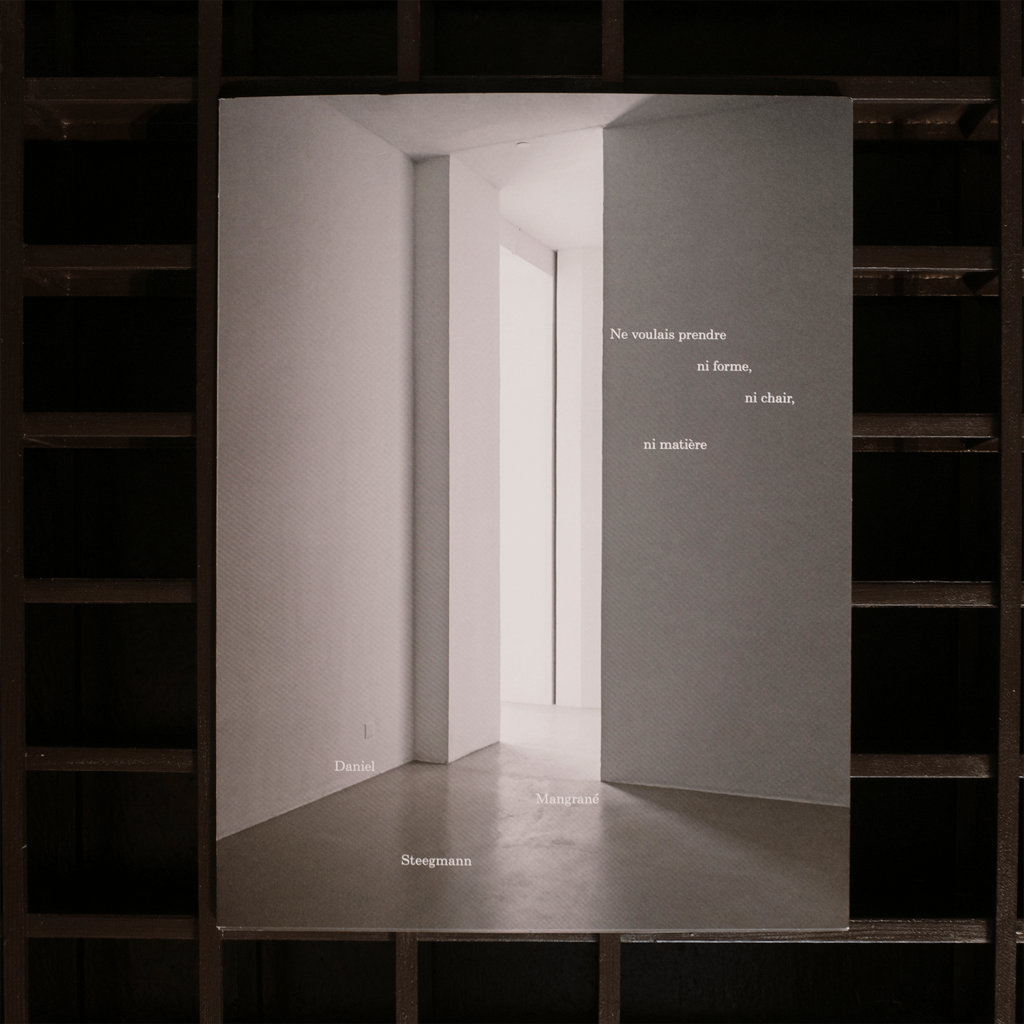
This publication documents the exhibition “Ne voulais prendre, ni forme, ni chair, ni matière” by Daniel Steegmann Mangrané at the Institut d'Art Contemporain de Villeurbanne, France in 2019. The catalogue includes first translations into French of the poems of Stela do Patrocínio, a Brazilian outsider poet who has longly inspired the artist in his research. Daniel Steegmann Mangrané has created a polymorphous work (drawing, sculpture, film, installations, etc.). His arrival in Brazil in 2004 was motivated by his fascination for the Amazonian forest – as a child he wanted to be a biologist, an entomologist or a botanist – as well as his discovery of Brazilian artists, Lygia Clark and Hélio Oiticica. Beginning at end of the 1950's, for the founders of the Neo-Concrete movement, intuition, subjectivity and public participation managed to reconcile outdated dualisms, starting with the commonly acknowledged opposition between object and subject. Also nourished by anthropology and the poems of Stela do Patrocínio, one of which inspired the title of this exhibition; in his work Daniel Steegmann Mangrané mixes natural and cultural forms. He explores how the living is entangled with its environment, experimenting with space as an area of the sensitive and of relationships. Impregnated by the Amerindian perspective of anthropologist Eduardo Viveiros de Castro – who blurs the distinction between human and non-human – and by the thinking of Philippe Descola who strives to go beyond the Nature-Culture dualism, Daniel Steegmann Mangrané intends to totally and profoundly transform the space of the IAC. And so, the path of the exhibition generates new vanishing lines, changing perspectives which open out towards the exterior. Defined by a sensitive geometry, driven only by rays of natural light that penetrate the gloom, it encourages exploration and groping and fumbling, as if willing visitors to rediscover the essence of the living itself. This path through the exhibition also translates the artist's fascination for the notion of dissolution, a dissolution of the subject which is likely to lead to an awareness of its surroundings. ↑ ↓ ↓
€24,00
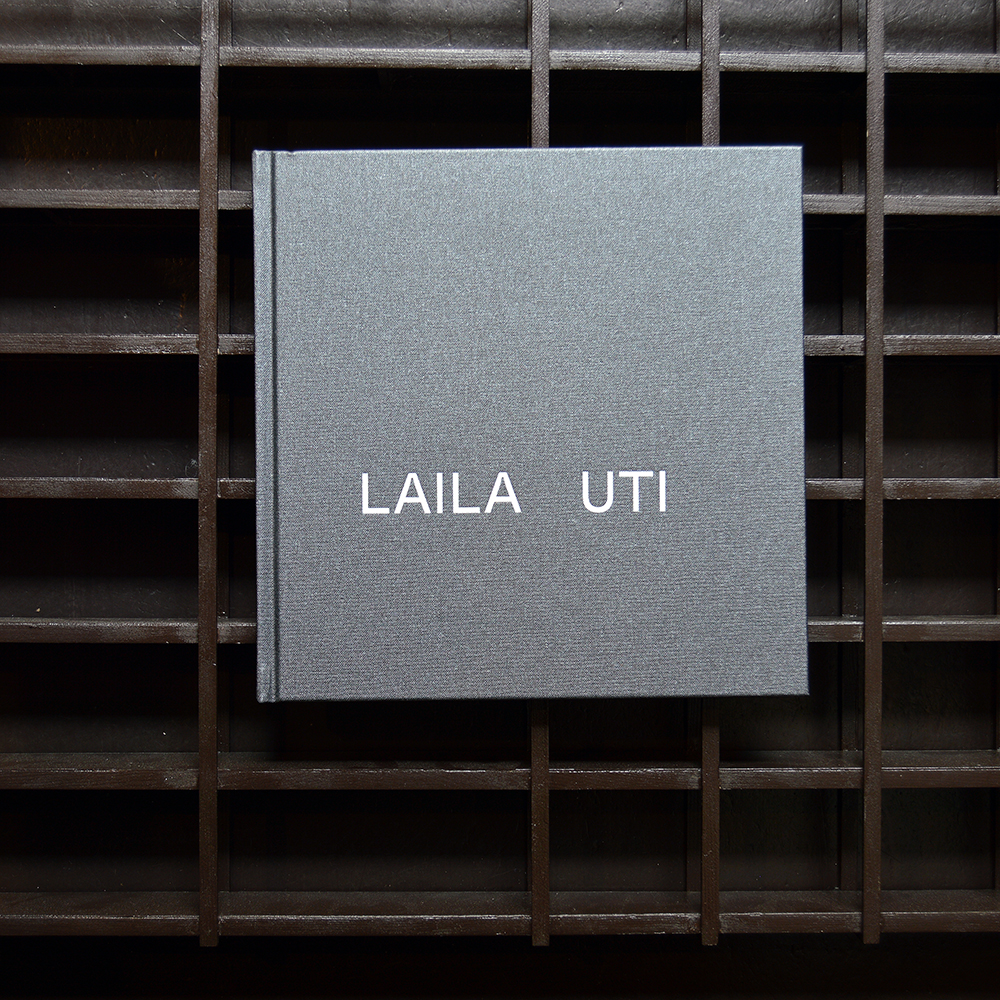
When Mette Winckelmann moved from Copenhagen K, a city center area, to Copenhagen N, near Nørrebros Runddel, her eyes immediately caught the strip of clothing stores that is a landmark of this specific area. One of them is LAILA UTI, located on Nørrebrogade 82. The lettering on the facade suggested that a B and a K were once part of the store’s name: LAILA UTI used to be LAILA BUTIK. Perhaps, at one point, the store even presented as LAILA UTIK or LAILA BUTI, that is if the letters did not go missing at the same time. Either way, the change of name also changed the store’s character and identity, if only in how its name is pronounced. Loss and letting go is also part of the history of the actual the book. The documented objects fade into each other in digital layers, creating new potentials in the absence of the letter Y (and consequently the colour yellow) in CMYK. LAILA UTI is published on the occasion of the exhibitions with the same name by the artist Mette Winckelmann at Viborg Kunsthal, and LAILA UTI / ULLA TILA at Augustiana in Denmark in 2019-2020. It contains, among other things perspectives on transformations, actions, paintings, clothing, architecture, patchwork, textile, scenography, building materials, concrete, patterns and layers. ↑ ↓ ↓
€32,00

Taking as its starting point Robin Fior’s personal collection, which was recently donated to the Calouste Gulbenkian Foundation’s Art Library, the exhibition Robin Fior. Call to Action/Abril em Portugal brings together, for the first time, objects conceived by the graphic designer both in England and Portugal, between the 1960s and the 1980s. The publication that accompanies the exhibition includes the contribution of Robin Kinross, author and editor of several essays and publications on visual communication and typography. His essay explores the beginning of Fior’s career and his English period, as well as his connection to the anti-nuclear campaign and his link to left-wing political movements. ↑ ↓ ↓
€10,00
SOLD OUT
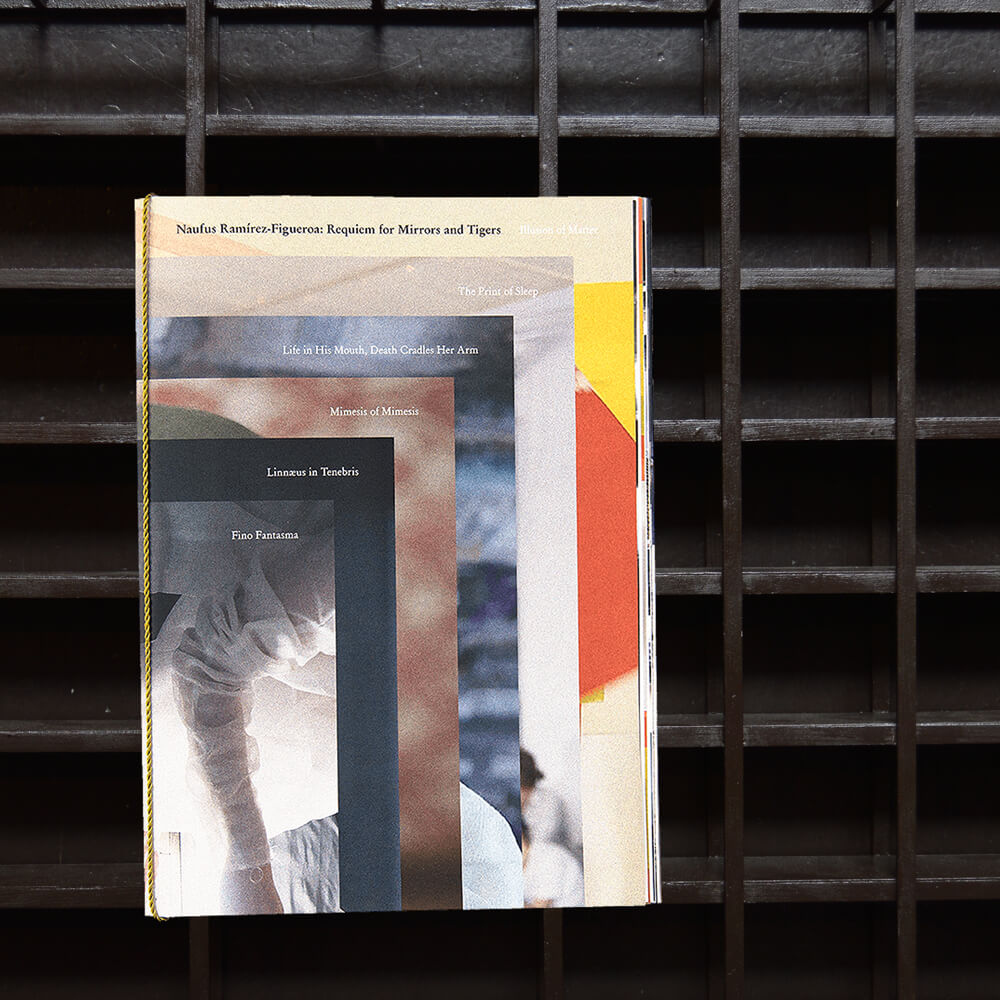
Naufus Ramírez-Figueroa: Requiem for Mirrors and Tigers catalogues the trajectory of a cycle of performances of the same name, through which the artist Naufus Ramírez-Figueroa attempted to exhaust his interest in the Guatemalan Civil War as a recurring subject of his work. Designed by Studio Manuel Raeder and published by If I Can’t Dance with BOM DIA Books, the publication documents the six performances in the cycle via foldout colour posters of each work, and an essay by Frédérique Bergholtz and Susan Gibb which offers descriptions of each performance alongside a reflection on the cycle as a whole. ↑ ↓ ↓
€19,00
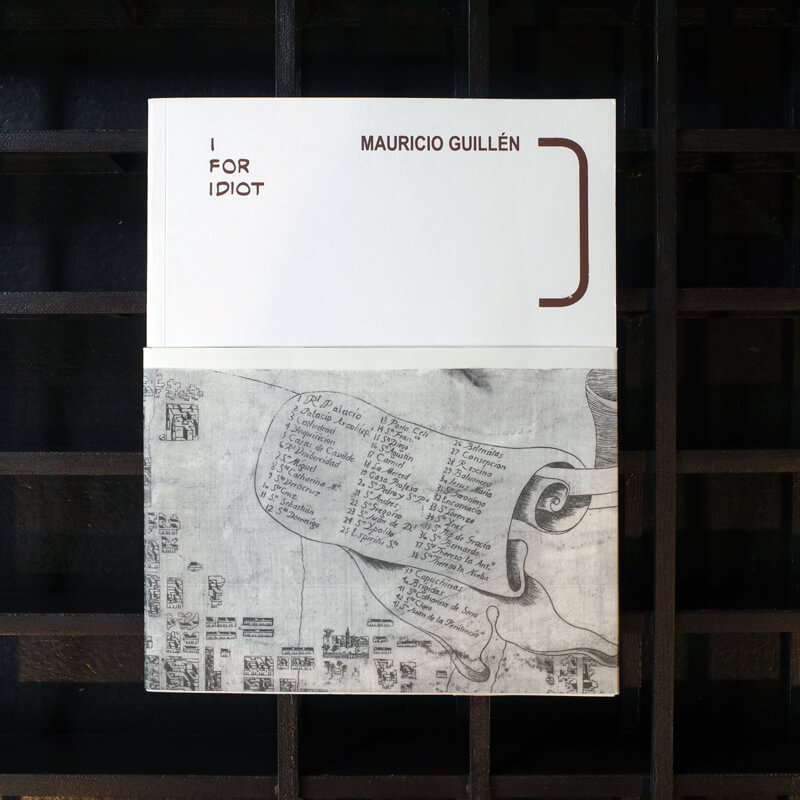
I For Idiot functions as an extension of the film Avenida Progreso in the sense that it assembles three different perspectives: a philosopher’s, an ethnologist’s and a film theorist’s, and juxtaposes these with some of the external layers of reality that have in one way or another informed the film. The purpose of this exercise, is to further consider the potential of dialectic time as a tool for collapsing linear narratives and analyzing the relation between speed, history and the distribution of knowledge in information based societies. The book was published on the occasion of the exhibition Avenida Progreso by Mauricio Gullién at the MMK Museum für Moderne Kunst, Zollamt, Frankfurt am Main (2012). ↑ ↓ ↓
€21,00

We are almost constantly surrounded by architecture, but we barely perceive it. Yet it has a major impact on our thought and actions – sometimes obviously, but usually unconsciously. The Colombian artist Gabriel Sierra is interested in precisely this psychological dimension of architecture. He aims to create an experiment that explores the intricate relation in between reality and perception. After all, built spaces are repositories for ideas, fears, and convictions; they are full of ambitions, traces, and future experiences, and possess multiple layers of time. Hardly any other experience demonstrates this as strikingly as déjà-vu, when we witness a moment as if it had already occurred. During a moment of déjà-vu, the present is transported backward in time; in it, the past, the future, and the present merge into a magical second that is both euphoric and unsettling. This publication has been published on the occasion of Sierra’s exhibition, Before Present, at Kunsthalle Zürich, that is dedicated to this unfathomable and uncanny Before Present. ↑ ↓ ↓
€24,00
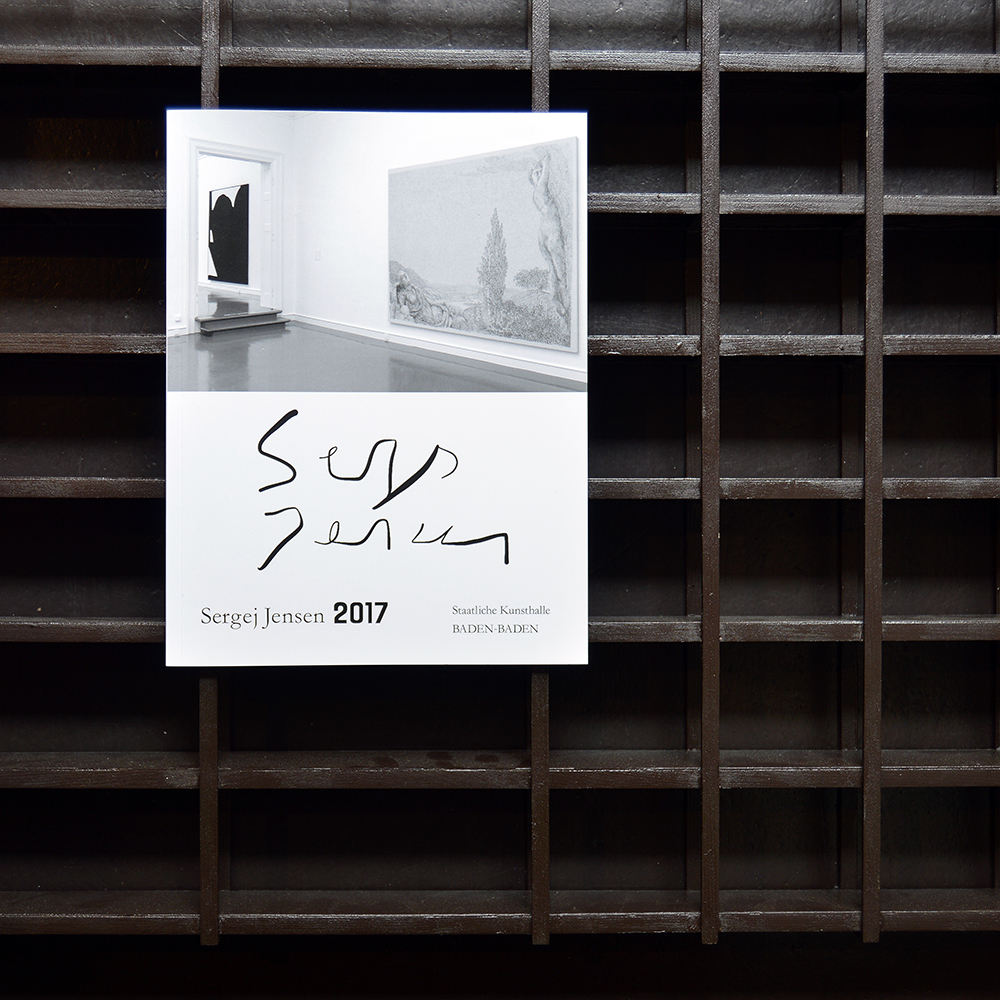
The catalog is published on the occasion of Sergej Jensen’s extensive solo exhibition at Staatliche Kunsthalle Baden-Baden in 2017. With over 40 works by the artist living in New York and Berlin, the show was presenting a selection of works from 2001 to the present. The publication contains texts by Mark von Schlegell, and Magnus Schaefer. ↑ ↓ ↓
€21,00
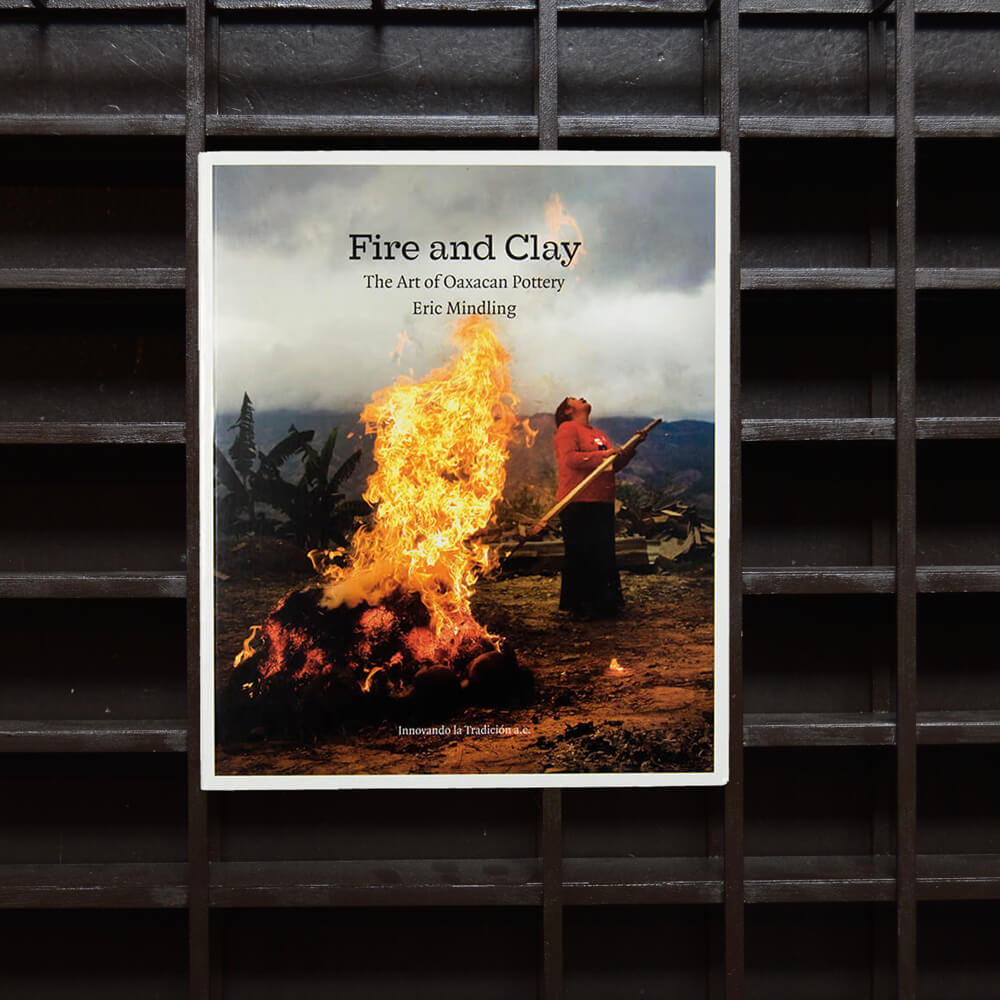
€26,00

For the last few months these pictures have been my monsters oft he week. They form the consequences oft he decisions I have taken and these consequences have an afterlife of consequences, which I have had to face. So, I accepted the fate that these fictions of mine have become truth – and more – actual materializations; that I have, from the depth of my windowless studio, unleashed another artwork upon a world already crowded with others.“ The publications includes works by Henning Bohl shown at Kunsthalle Nürnberg, Pro Choice / L’Ocean Licker, Galerie Meyer Kainer, Casey Kaplan, published on the occasion of the exhibition held at Kunsthalle Nürnberg 2012 / 2013. ↑ ↓ ↓
€19,00
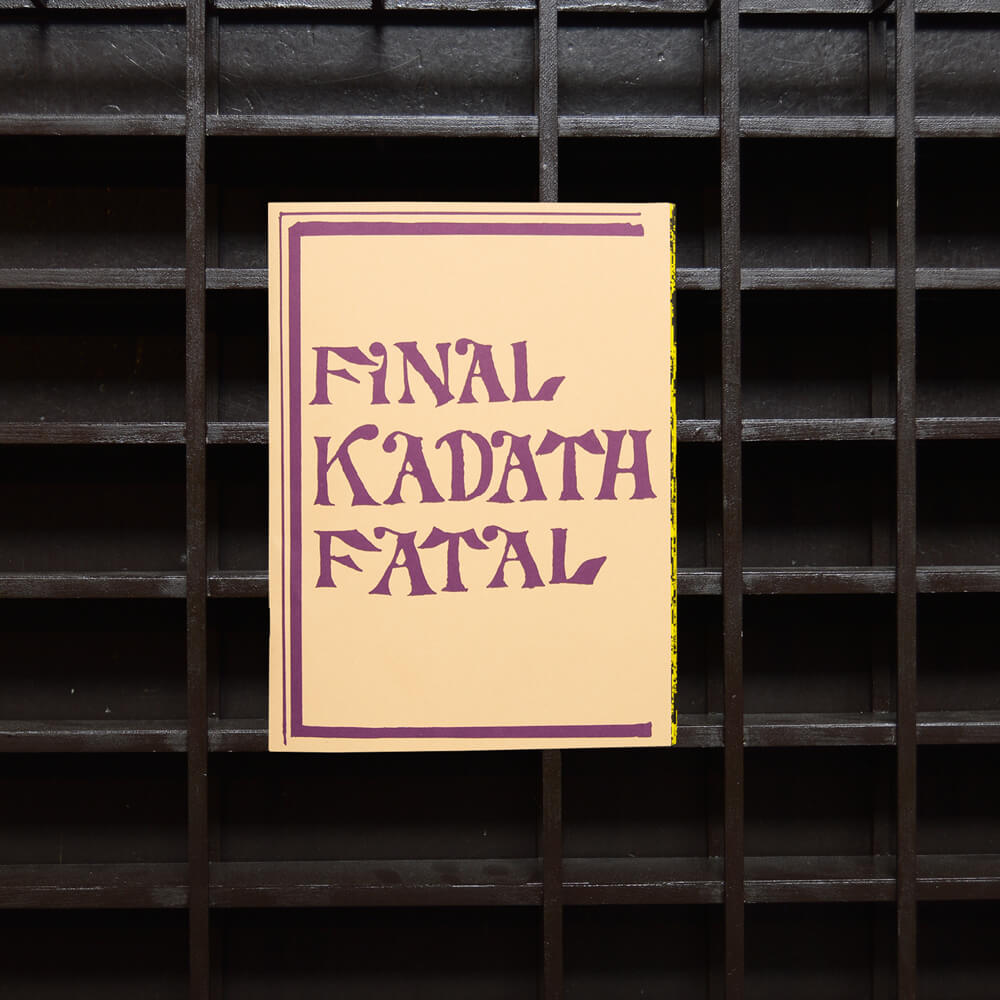
Final Kadath Fatal is the third and last volume in a series of artist books by Henning Bohl. The title loosely refers to H. P. Lovecraft’s novella The Dream-Quest of Unknown Kadath (1926/27), in which Kadath appears as a mystical place to where the gods have betaken themselves “in the cold waste where no man treads.” The publication accompanies Bohl’s installation of four large-scale murals for the subway embankment wall along Paltaufgasse in Vienna’s 16th district, whose rough-faced, square-dressed stones are reminiscent of imperial architectural gestures like the rusticated facade of Palazzo Medici in Florence. It has been on display since Summer 2016, made possible by KÖR – Kunst im öffentlichen Raum Wien. ↑ ↓ ↓
€16,00
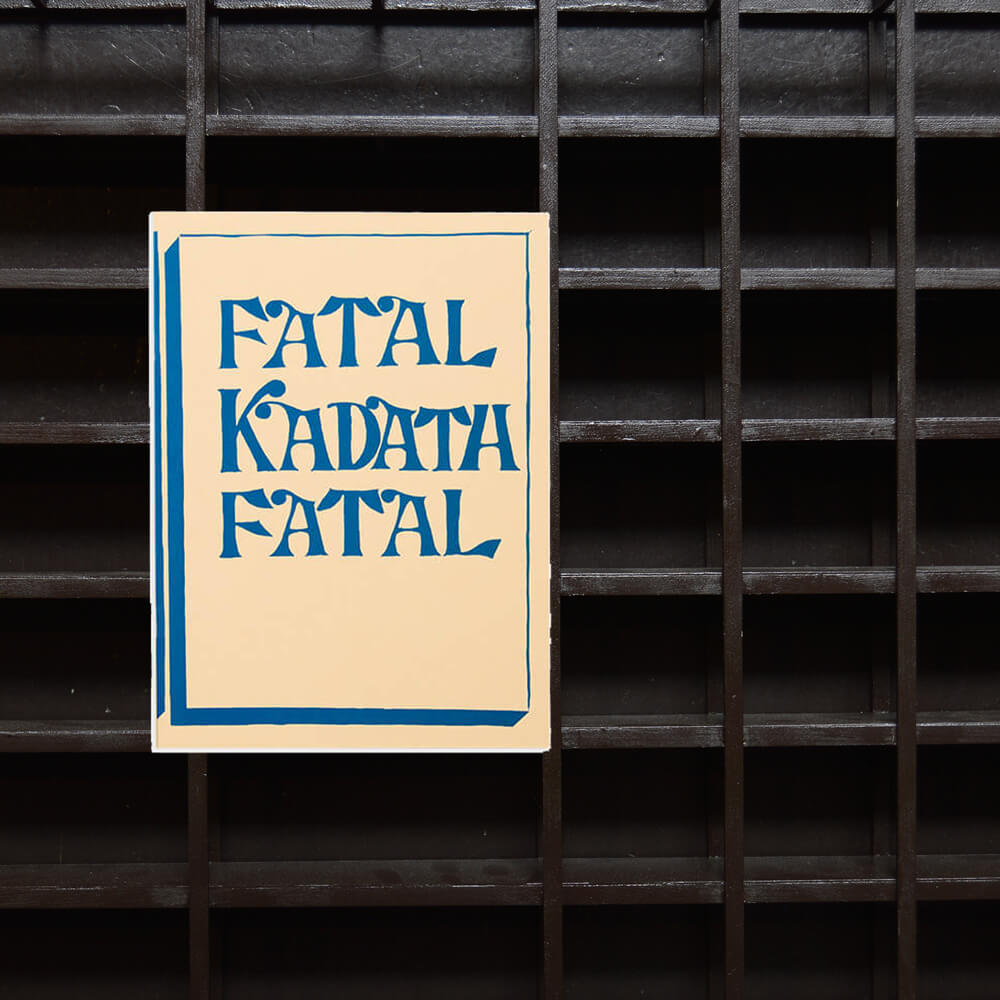
The title of this book references a mythical peak where gods dwell ‘in the cold waste where no man treads’ described in H.P.Lovecraft’s ‘The Dream Quest of Unknown Kadath’ (1926/27). Lovecraft’s novel itself drew from William Beckford’s gothic horror ‘Vathek’ (1786), Robert W. Chambers’ ‘The King in Yellow’ (1895) and the novels and short stories of Lord Dunsany. Bohl’s drawings refer to a wide variety of popular and archetypal imagery familiar to him from his adolescence. They incorporate styles learned from, amongst others, Aubrey Beardsely, Métal Hurlant comic books and Blair Reynolds and other graphic artists associated with Pagan Publishing. As with his previous works, these drawings employ modest yet very specific materials. ↑ ↓ ↓
€16,00
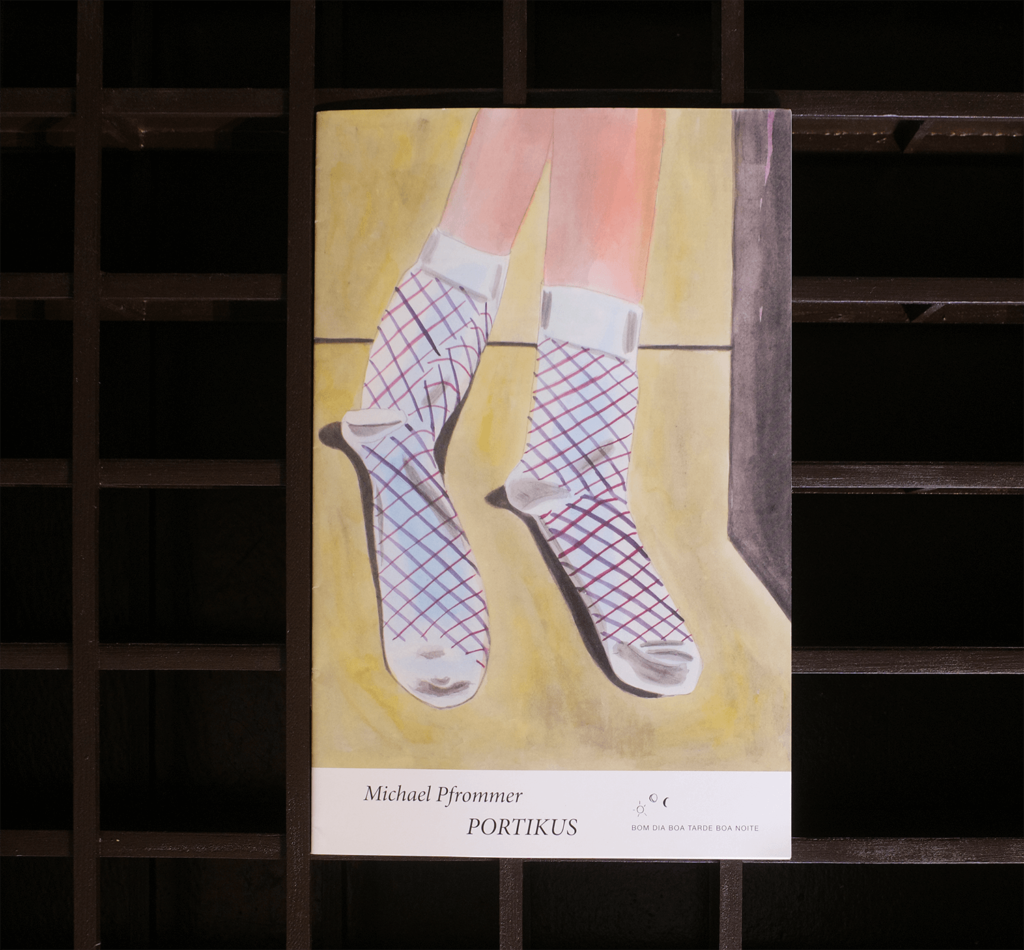
€5,00
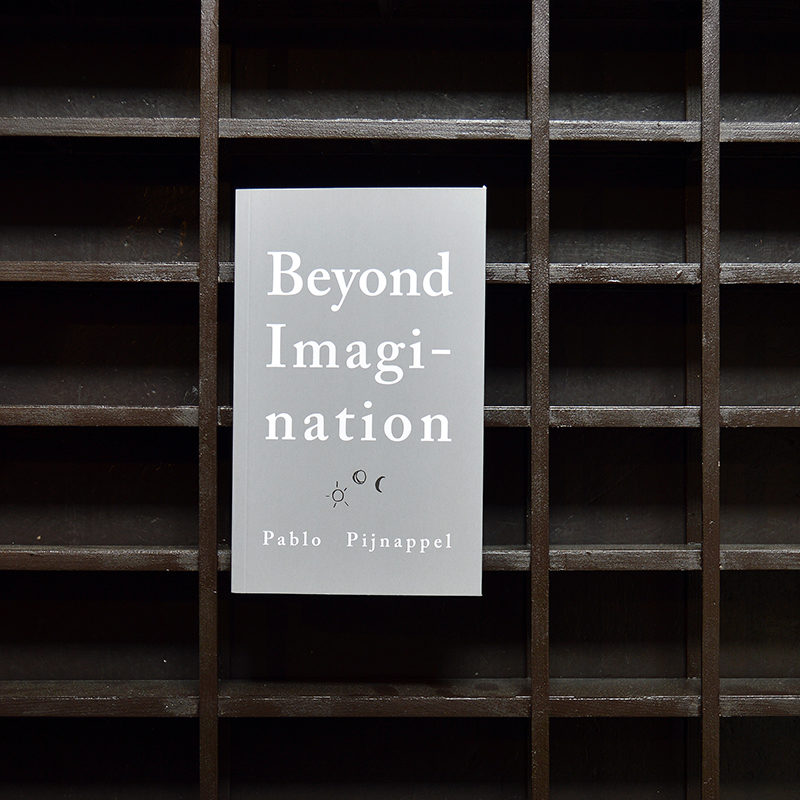
English and Portuguese texts. This book was published on the occasion of the artist’s solo exhibition, Zona de Crepúsculo, at the Iberê Camargo Foundation, Brazil, in 2018, curated by Bernardo José de Souza. The following texts are a rendering, in written form, of monologues included in his performance The Zone, 2015-2018. The artwork consists of an after-hours tour in and around a given exhibition space, where a series of found narratives are performed by the artist. With psychoanalysis and literature as his usual starting points, Pablo Pijnappel’s works are meta-narratives that poetically combine cultural, historical and ancestral identities through the prism of memory. Language always plays a leading role in uniting mental mechanisms and the world, in video installations, texts, or performances that lie at the crossroads between cinema, photography, and fragments of prose. ↑ ↓ ↓
€14,00

This publication, in form of a leporello, captures a singular sixty-meter-long (one-hour) drawing by artist Tanaz Modabber. Conceived with the core idea that the piece would shift form, scale, and tone through multiple stages of translation, the work’s latest transition manifests as this artist-annotated publication with accompanying essay by Cassandra Edlefsen Lasch. Activated by varying means, the scroll-like drawing has been read as a score as well as, in this format, the basis for an expanded referential mapping. Along the length of the published piece a collection of images suggests potential relationships between prosody in poetry, music, architecture, and politics in Iran. In 2014 an hour-long video of the meandering drawing was displayed as notation for a prize-winning sound composition performed by Modabber and sound composer Pierre Mourle within the Tokyo Experimental Festival Vol. 9. The visual composition remains open to interpretation in future texts, sounds, and spatial arrangements. ↑ ↓ ↓
€24,00

Nora Schultz’s work explores questions of the emergence of pictures and production as an artistic dynamic. She is more interested in the genesis of images and objects and its material traces than in the completed work. That is why the manufacturing process plays a central part in her prints, printing machines, installations, and performances and always remains recognizable as such. The book figures as a sort of retelling in which manhole cover stamp, die-stamping drum, paper, plastic, and aluminium sheet, camping mat, microphone sculpture, dictaphone, sound funnel, and print worm blithely continue their cycles of production. ↑ ↓ ↓
€19,00
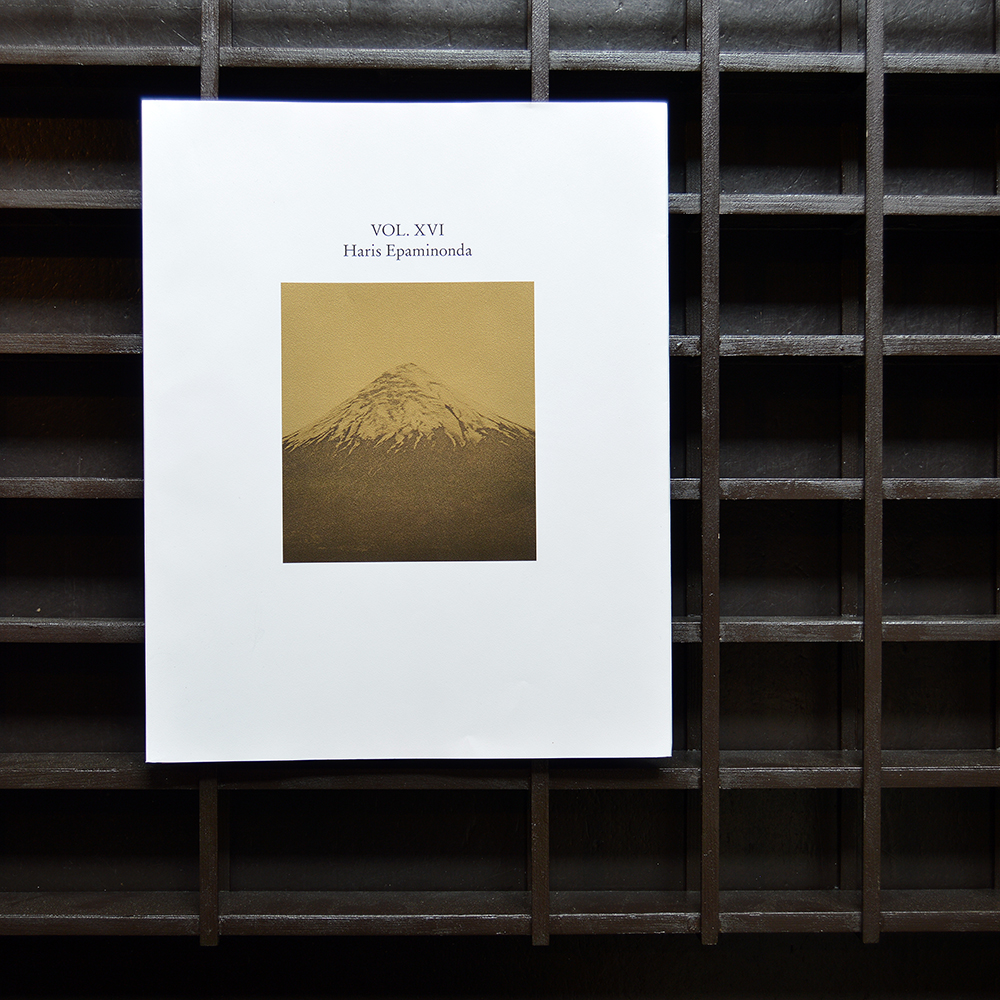
The publication is a collaborative project bewtween Frac Île-de-France, the Cypriot artist Haris Epaminonda, and the Berlin designers Santiago da Silva and Simon Steinberger. It recounts and translates the experience of the exhibition VOL. XVI, presented at Le Plateau in 2015, for which the artist had created a global environment. Through a series of parallel actions the whole exhibition was connecting the interior and exterior with the presence of an old Japanese man “living” in the exhibition and with two young women dressed in traditional Japanese costumes who were walking in the des Buttes-Chaumont Park in Paris. This book concentrates the different perspectives of the artist’s work, where the idea of travel, of displacement – in time and space – offers a unique spatial experience combined with the cinematographic dimension included in the exhibition. At the same time, are gathered the critical texts of Philippe Artières (Historian and Research Director in CNRS, EHESS), Chris Sharp (Independent art critic), and Aurélie Verdier (Curator in Musée national d’art moderne, MNAM-CCI, Centre Pompidou). ↑ ↓ ↓
€25,00
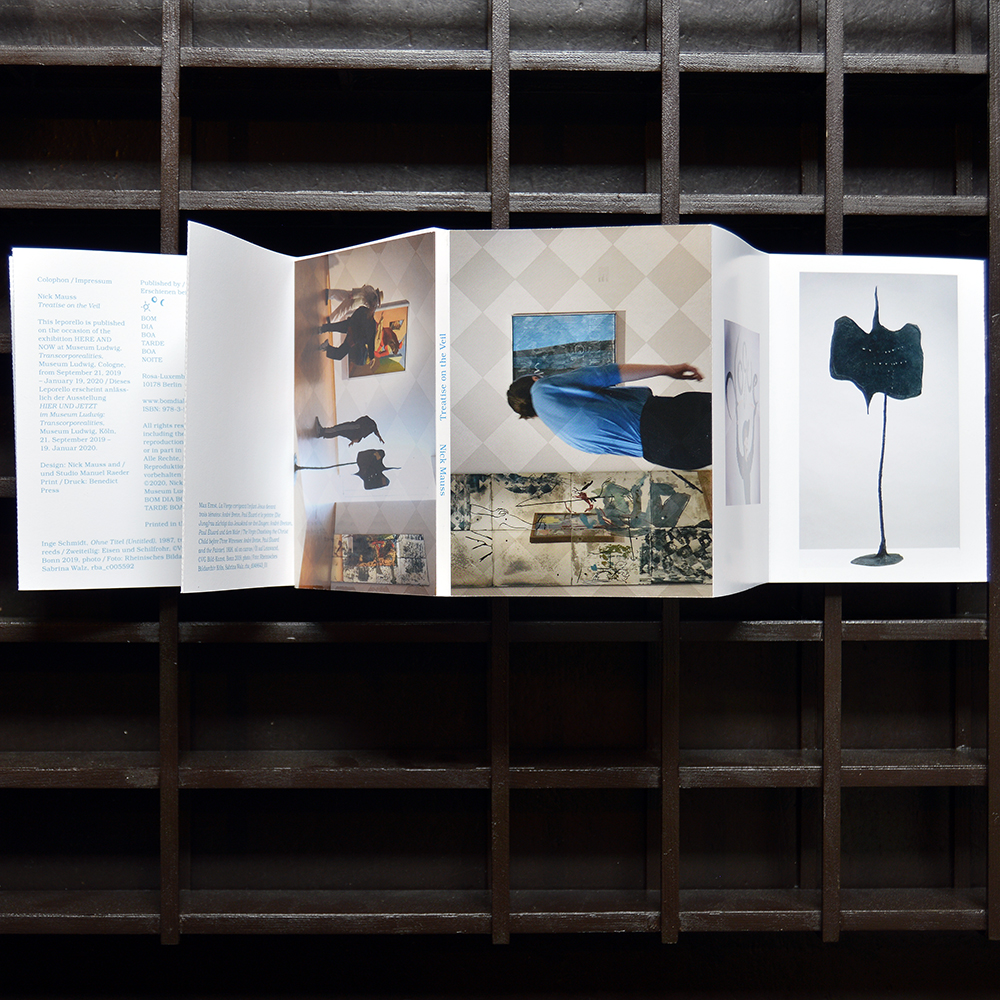
Nick Mauss’ artist’s book comes in the form of a postcard accordion with a wrap-around cover sleeve, reproducing artworks presented as part of his contribution to HERE AND NOW at Museum Ludwig: Transcorporealities, curated by Leonie Radine. Featuring works by George Brecht, Inge Schmidt, Jack Smith, Max Ernst, and Mauss, amongst others, this leporello recalls the juxtapositions and interrelationships among artworks and performers brought together within the permanent collections galleries of the Museum Ludwig for the duration of the exhibition, confounding representations of the body, the utterance, and the event. ↑ ↓ ↓
€14,00
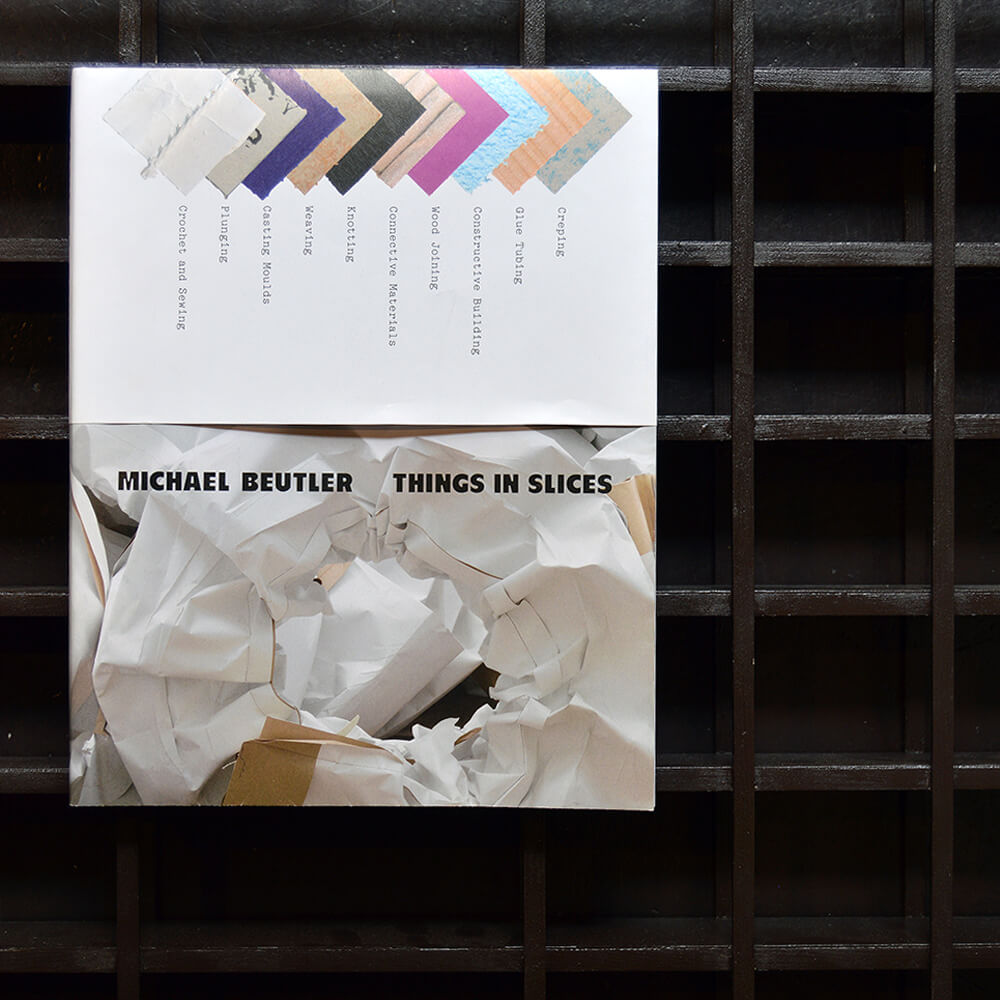
The publication, presenting the artist’s own classification system, is a congenial travel companion into the world of Michael Beutler’s artistic practice. It functions as a field guide and helps to decipher his heterogeneous production via its components, tools and production methods in relation to specific sites and situations. The texts give insight into the background story and construction of each work based on various specifications. ↑ ↓ ↓
€36,00

An artist book with four visual poems by Emmett Williams including 'SOLDIER' and 'Fête Duchampêtre' printed in colour. An expansive book where Williams uses the space of over 200 pages to experiment with colour, typography and fragmentation of texts elegantly furthering the movement of a flip-book style form. ↑ ↓ ↓
€26,00
SOLD OUT
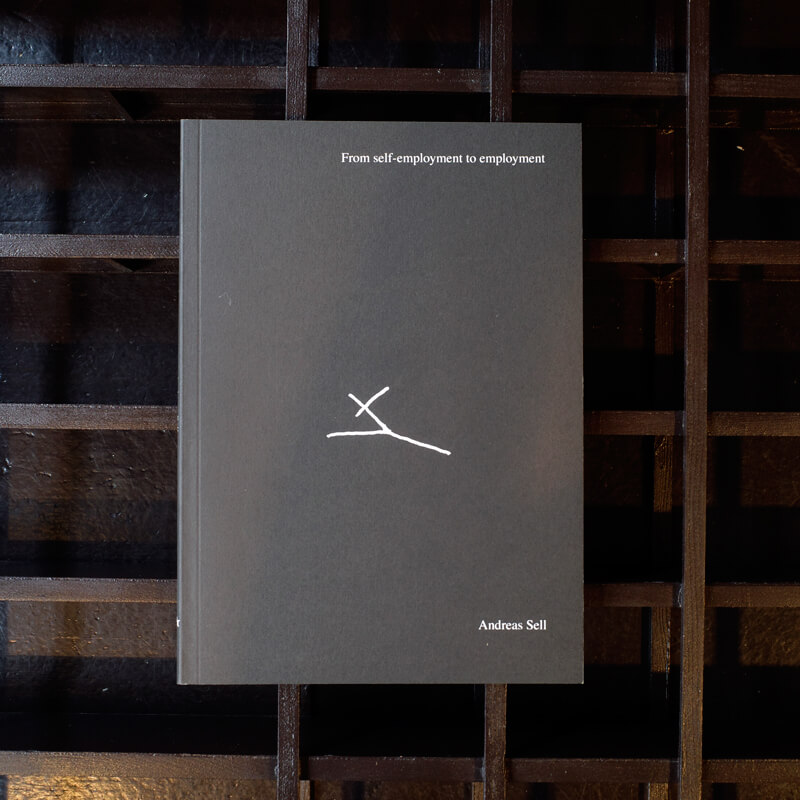
€17,00

This book is a close collaboration between artist Jorge Méndez Blake, curator Rodrigo Ortiz Monasterio, and designer Santiago da Silva in the mutual interest on unfinished novels, libraries and the connections that can be made between literature and architecture. Não de China (China Boat) takes as a departure point José Juan Tablada’s writings, seeking the missing connections in order to produce a series of encounters and perspectives into his literature. By unraveling Tablada’s oeuvre, imagining his lost or unfinished works, this book attempts to give contemporary interpretations of some of the seminar themes in his work: Orientalism, the relation between literature and visual arts, and the creation of national identity through art and architecture. This book is written in English and Spanish. ↑ ↓ ↓
€19,00

In this collection of stories and illustrations, Anna M. Szaflarski examines the subject of violence, in particular as it is experienced through the female body. Beginning with an autobiographical experience, the story triggers a dissociative state that plunges the book in and out of imaginary worlds and associative narrative threads. ↑ ↓ ↓
€25,00
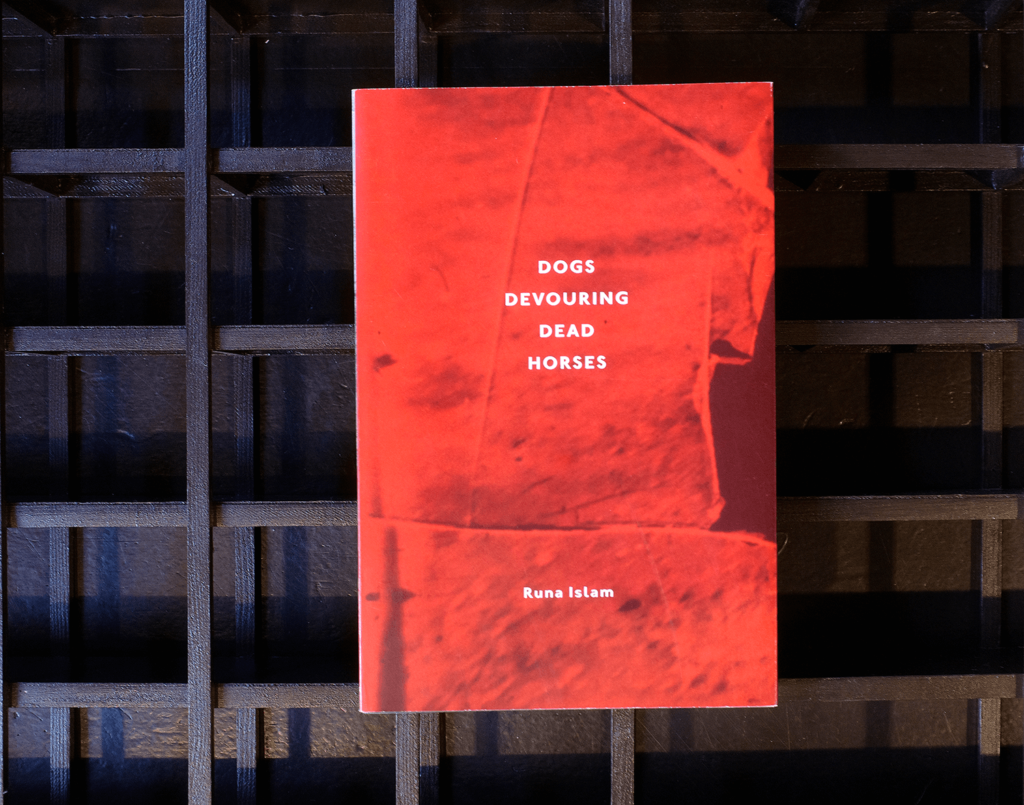
Dogs Devouring Dead Horses was a collaboration between the artist Runa Islam and the designer Manuel Raeder subsequent to the exhibition she held at the Museum of Modern Art in New York (Projects 95, 2011). The artist provided Raeder with stills from four films on display: Emergence (2011), This Much Is Uncertain (2009–2010), Magical Consciousness (2010) and The House Belongs to Those Who Inhabit It (2008). And Raeder, according to the introduction by Milovan Farronato, „gave back to Islam a ‘sculpture in print’ that does not just document the exhibition and offer a view of the three newer works on display, but draws upon the concepts underpinning the exhibition and the work of the filmmaker.“ ↑ ↓ ↓
€24,00
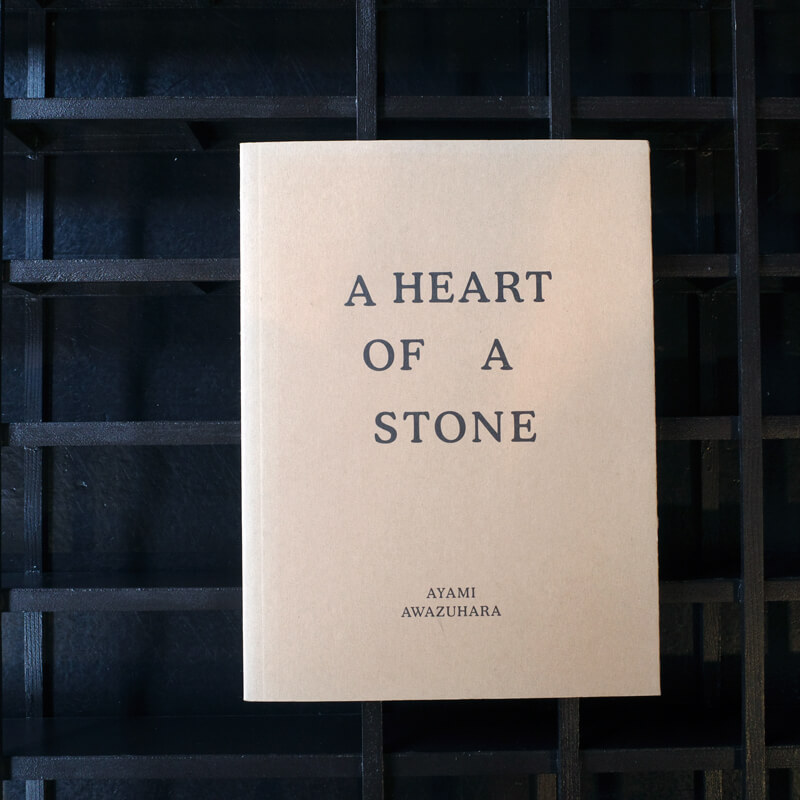
Do we think that a stone is a cold and dead material or rather warm and vital? A Heart of a Stone is published as part of the installation by artist Ayami Awazuhara. The work consists of several elements arranged in various display structures. The book A Heart of a Stone is part anecdote, part fiction and part sculpture. It was developed in a collaboration with Santiago da Silva. ↑ ↓ ↓
€14,00
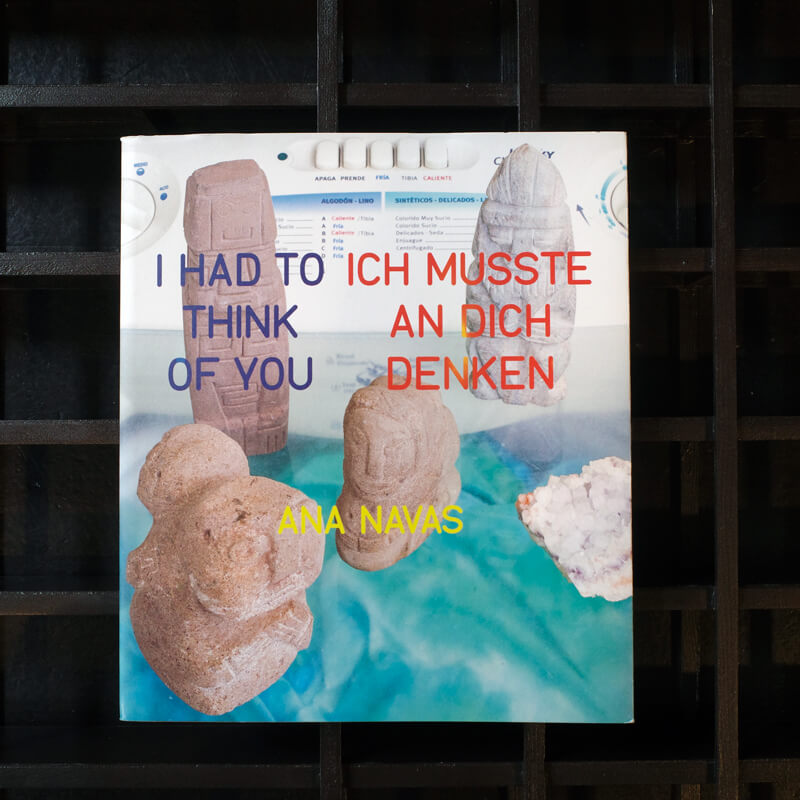
Ana Navas explores the border between design and art. Playfully, she tries to track down the mechanisms of how design affects our consumption of goods and investigate the essence of the possibilities to assimilate art in a context-free environment. The catalogue published on the occasion of the first institutional exhibition by Ana Navas at Galerie der Stadt Sindelfingen continues her artistic research, which deals with phenomena such as memory, translation, interpretation and authorship and documents a wide exchange of images and ideas. A collection of photographs the artist received from friends and acquaintances provides an insight into how her work is influenced and understood by others under the motto ‘I had to think of you’. ↑ ↓ ↓
€24,00

Rosetta is one of the most popular restaurants in Mexico City. Since its doors first opened in 2010, it has reinvented what a Mexican restaurant can be: through sincere, ingredient-based cuisine that both revives and challenges tradition; through its commitment to serving local and seasonal produce grown by small-scale, sustainable producers; and through its location and attention to detail, creating a vibrant and welcoming atmosphere. The first book by Elena Reygadas, chef and owner of Rosetta, is more than a cookbook. For one thing, she shares a selection of her recipes from the present and the past. But she also offers a series of reflections on many different topics: from the social and environmental impact of industrialized food, to personal recollections, to the history of little-known Mexican ingredients. ↑ ↓ ↓
€39,00
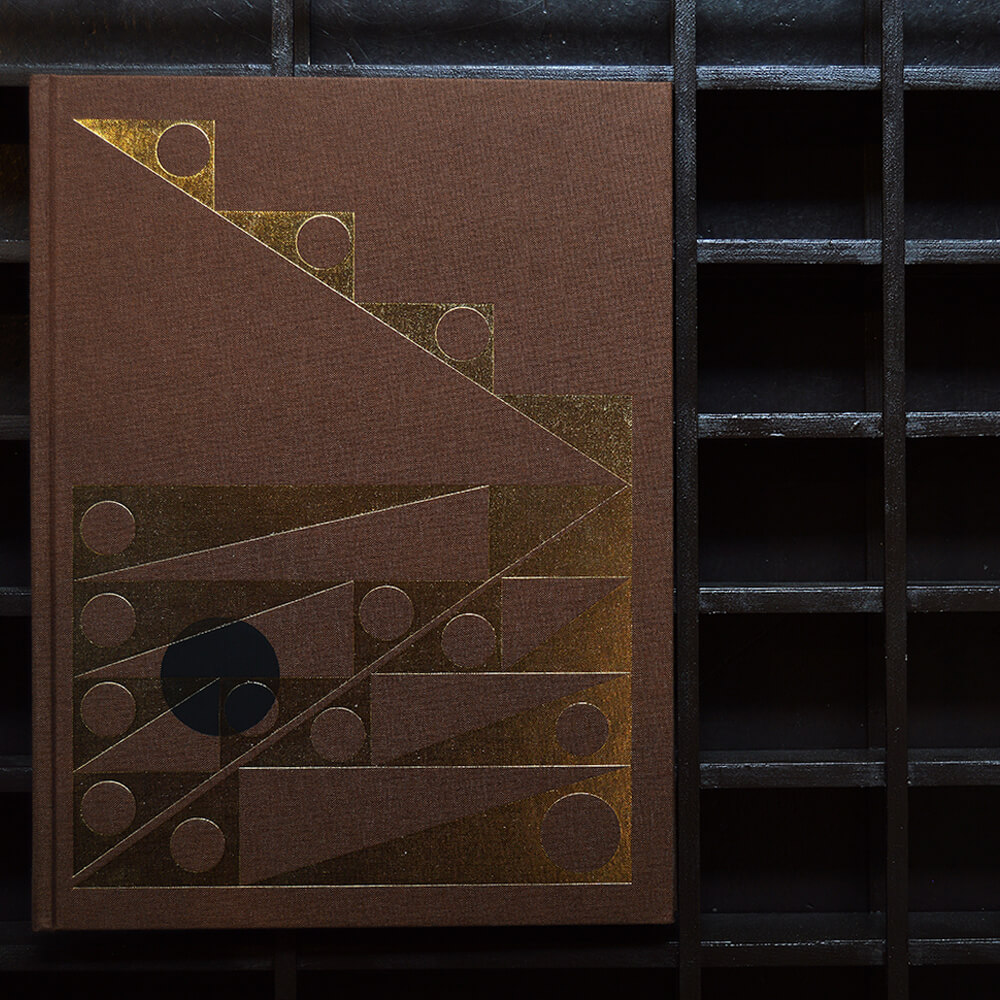
Eamon Ore-Giron’s first artist book pairs paintings from his ongoing Infinite Regress series with original poetry by scholar Edgar Garcia, offering a rich linguistic and visual context for understanding Ore-Giron’s work. Rendered on raw linen, Ore-Giron’s brightly-hued paintings fuse the tradition of Peruvian goldwork with the geometries of hard-edged abstraction. His compositions evoke the cosmos and notions of an ancient global architecture, creating optical play and a multiplicity of planes on the canvas. Garcia has written “poetry thick with” abstraction, exploring the role of the formal and theoretical within Ore Giron’s work through his own research and work exploring the hemispheric literatures and cultures of the Americas. His “Tractatus” examines the apprehensibility of origins in their visual and poetic forms, and traces a contemporary conception of origins in the knot, fold, crushed stone, haunted bone, and constellation of everyday emergencies. ↑ ↓ ↓
€44,00
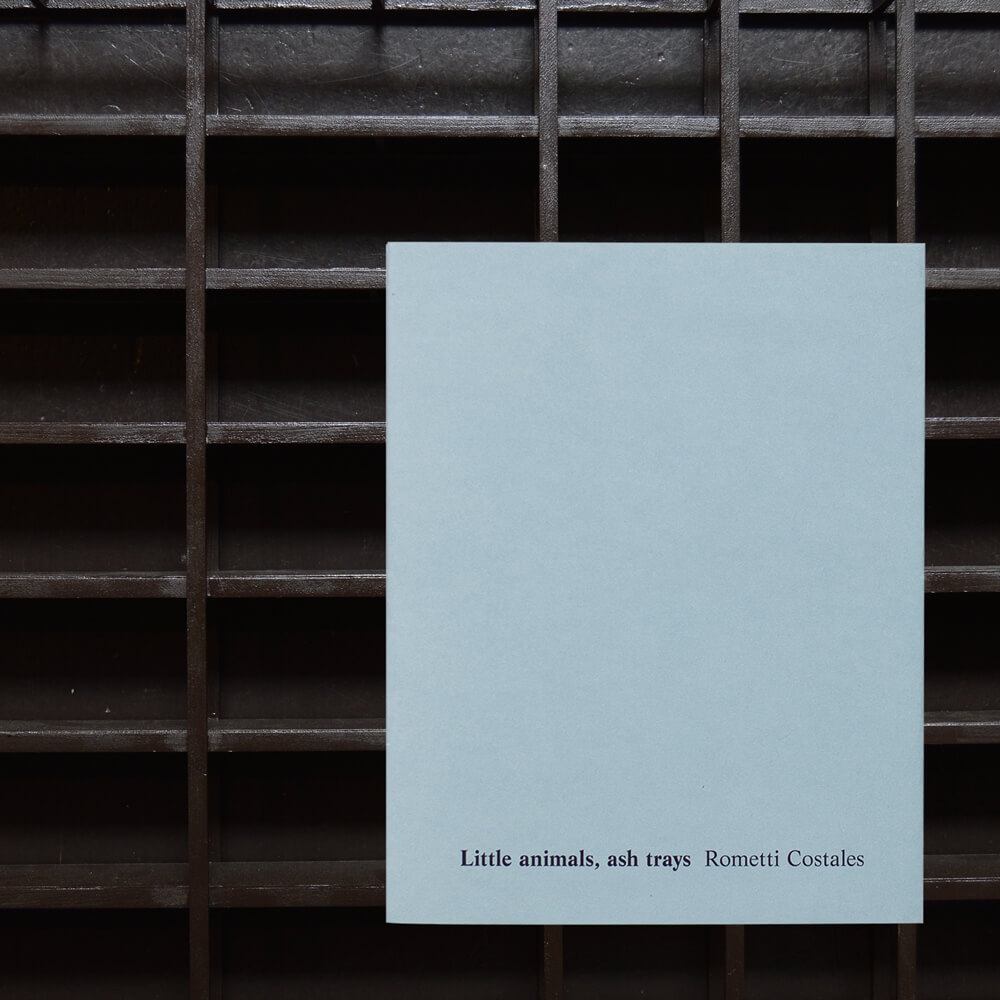
The book accompanies Little animals, ash trays (a project by Rometti Costales in the CA2M Centro de Arte Dos de Mayo, Madrid) and functions as a compendium of distinct materials that revolve around their artistic practice of the last few years; at the same time it is an essential component of the project. The book is structured by a conversation between the artists and Juan Canela, curator and editor of the book, which provides space for a range of graphic materials and various contributions written specifically for it by Quinn Latimer, Yasmil Raymond, Elfi Turpin, Magalí Arriola, and Manuel Cirauqui. This book is written in English and Spanish. ↑ ↓ ↓
€25,00
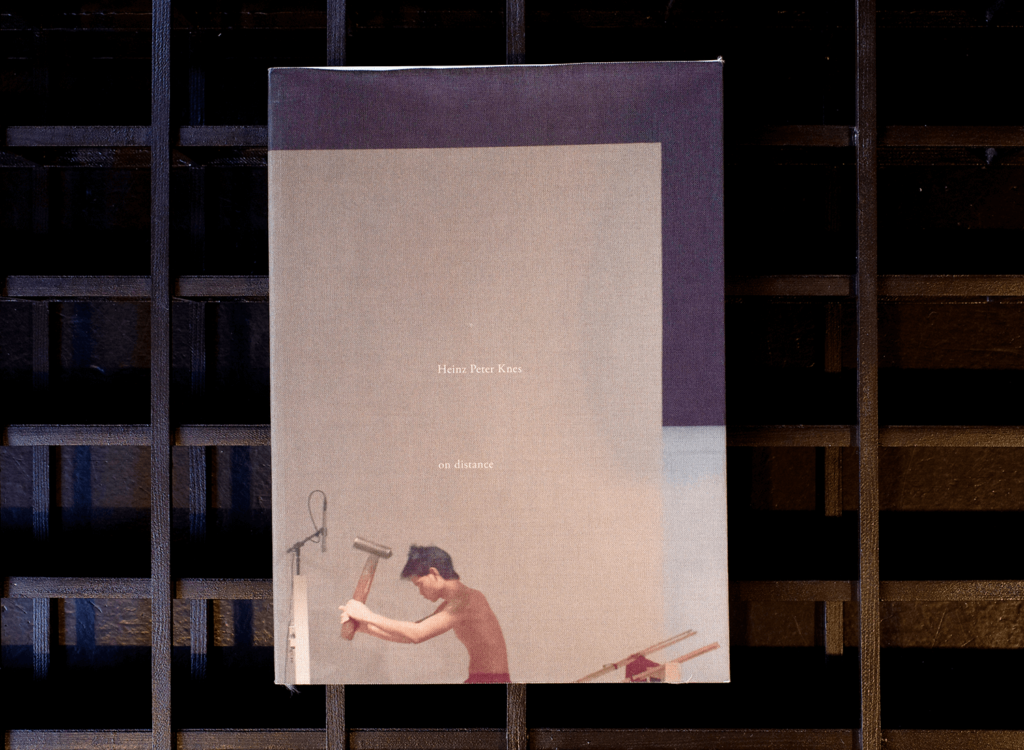
on distance is a volume of photographs by Heinz Peter Knes representing a small selection from his extensive archive of travel photography dating back to 2010. Unlike a conventional approach to a personal travel log the photos and their ordering reflect upon broader cultural themes driven by personal interests, desires, and chance. Knes, in conversation with Julie Ault, ordered the images according to subjective and associative categories influenced by Warburg’s “law of the good neighbor”, Warburg’s principal of library organization based on the exchange and mutual engagement between books placed next to each other, rather than classical groupings such as “fine art” or “photography.” on distance opens up a similar research into the possible languages that emerge within images. ↑ ↓ ↓
€19,00
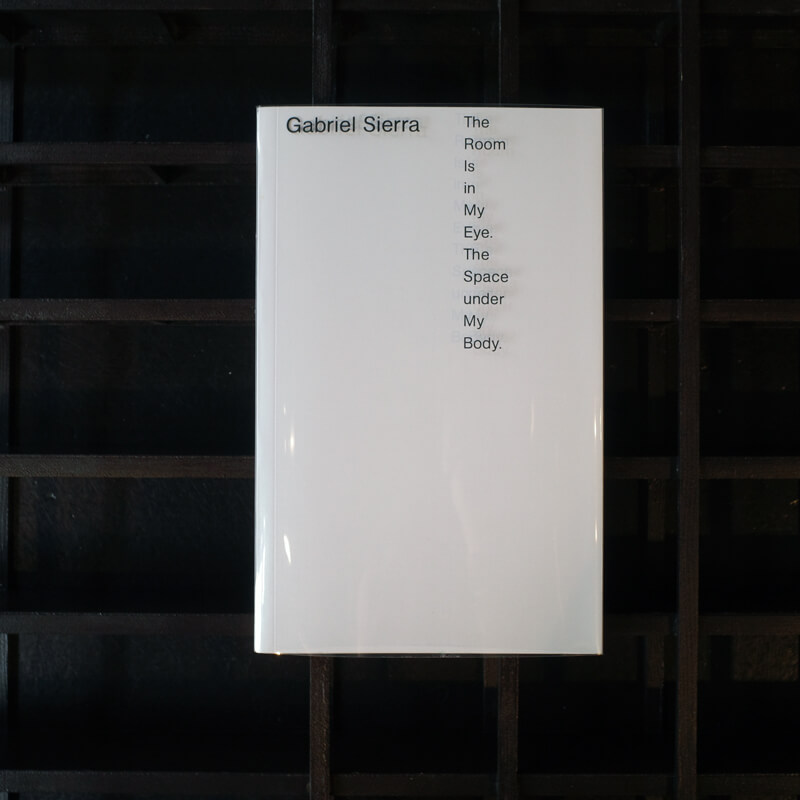
This publication is a continuation of Gabriel Sierras site-specific installation project at the Renaissance Society in 2015. Sierra is intrigued by the language of the spaces in which we live, work, and think. His practice employs a variety of techniques to examine how the human body functions in relation to its environment. The Bogotá-based artist’s first solo show in the United States consisted of a group of constructions to stand in, walk over, or lie down in, and relating abstractly to the idea of inhabiting different moments of space and time. The title of the exhibition changed every hour to frame the specific moment in which the visitor experienced the work. ↑ ↓ ↓
€24,00
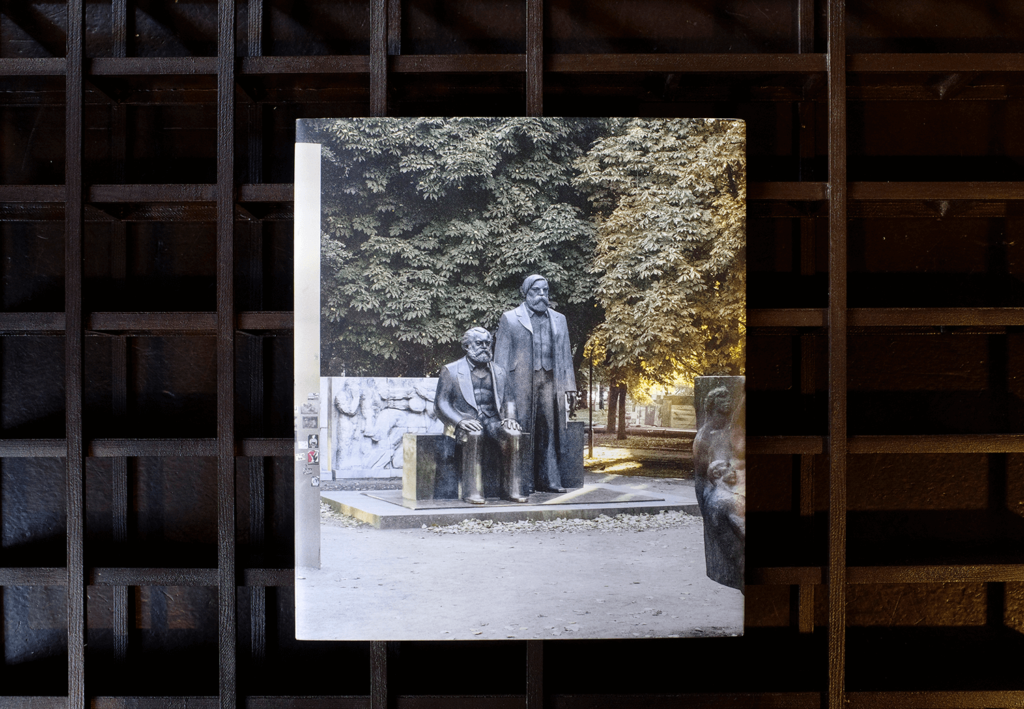
In 1986, four double-stelae were erected in Berlin as a part of the Marx-Engels-Forum, which display 144 photographs, showing the development of the working class. Commissioned by the state, filmmaker Peter Voigt and photographer Arno Fischer developed a formal translation for Marx’s and Engel’s philosophy of history. In line with their documentational focus, the two artists were concerned with demonstrating the historical situation of the international working class, its grief, and its overcoming. The photographs, compiled from archives worldwide, constitute the foundation of the project. The chosen motifs respond to historical events as well as figures, depict everyday life and illustrate “circumstances”. ↑ ↓ ↓
€28,00

Kukje Gallery is pleased to present When The Year 2000 Comes, a solo exhibition by Haegue Yang, an internationally recognized artist based in Seoul and Berlin. This is the artist’s first exhibition at Kukje and fourth solo exhibition in Korea since her last presentation at Leeum, Samsung Museum of Art in 2015. ↑ ↓ ↓
€25,00
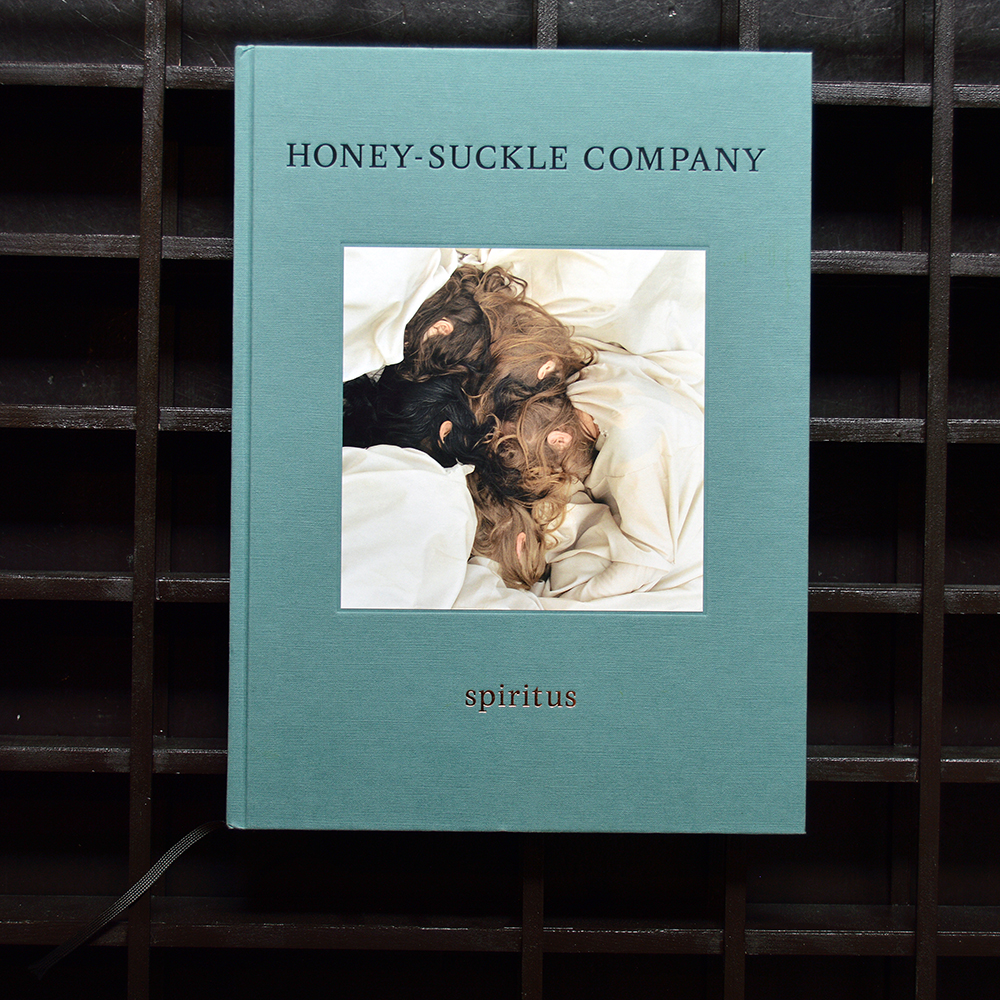
Die genaue Geschichte der HSC muss erst noch geschrieben werden, was eine schwierige Aufgabe für Kunsthistoriker darstellt – besonders, weil sich die HSC bisher sehr geschickt und konsequent gegen jeglichen Versuch, ihre verschiedenen Aktivitäten und Manifestationen einzuordnen, gewehrt haben.” Adam Szymczyk, Leiter documenta 14 ↑ ↓ ↓
€38,00
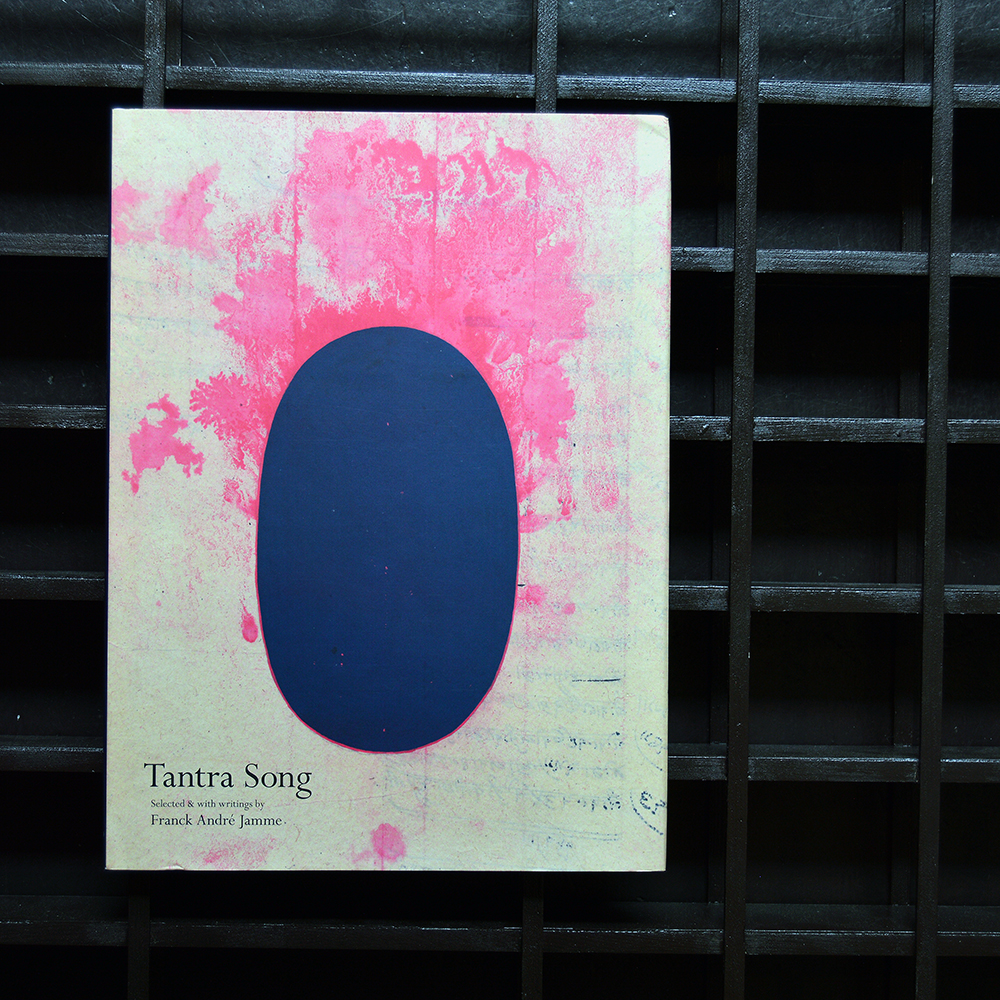
Those who feel the truth of 14th century German theologian Meister Eckhart’s words, “When the soul wants to experience something she throws out an image in front of her and then steps into it,” might do well to consider Franck André Jamme’s latest book, Tantra Song: Tantric Painting from Rajasthan from this point of view. It is an evocation of the image as a threshold leading to new dimensions of meaning, a revelatory understanding that some images are more than mere data; they are instead vital seeds, living carriers of possibility. ↑ ↓ ↓
€35,00
SOLD OUT
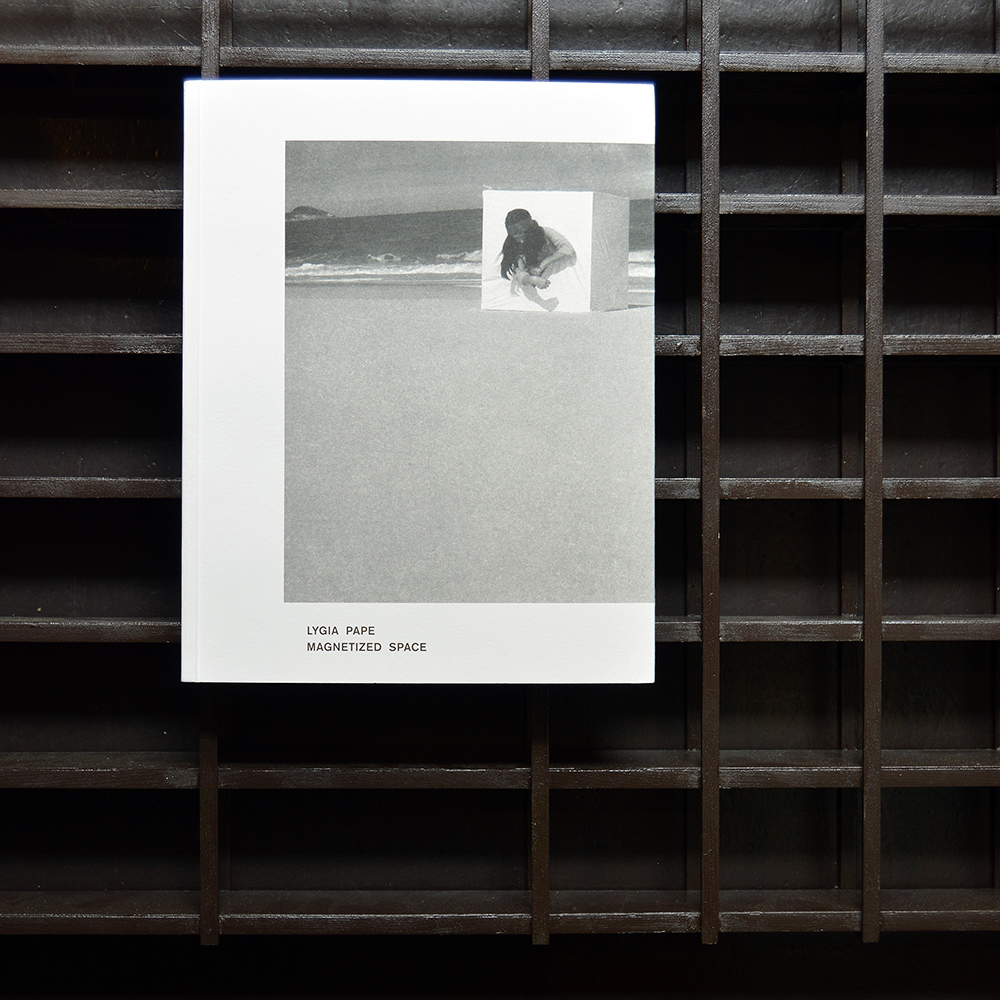
Brazilian artist Lygia Pape was a founding member of the Neo-Concrete movement, which was dedicated to the inclusion of art into everyday life. Her early work developed out of an interest in European abstraction, however, she and her contemporaries went beyond simply adopting an international style, and started to draw on their own local situation. Neo-Concretism is often seen as the beginning of contemporary art in Brazil, and Pape's work—which focus on the coming together of aesthetic, ethical, and political ideas—has formed an important part of Brazil's artistic identity. ↑ ↓ ↓
€40,00
SOLD OUT

This book, the first critical study of Jean-Luc Moulène's work, brings together leading scholars to examine the artist's diverse aesthetic strategies and interests in the relationships between social and political arenas and systems and orders, including geometry, mathematics, social sciences, and human behavior. Featured essays also examine Moulène's theoretical and playful inquiries into the plasticity of materials and the ways we see and understand both still and moving images. ↑ ↓ ↓
€40,00

Now in paperback, this volume presents an overview of the legendary Canadian collective. Founded in Toronto in 1969 by Felix Partz, Jorge Zontal and AA Bronson, the trio adopted a generic identity that "freed it from the tyranny of individual genius." Their intermingling of reality and fiction took the form of a transgressive, often parodic take on art and society. Paintings, installations, sculptures, photographs, videos, magazines and TV programs: General Idea's is an authentically multimedia oeuvre that has lost nothing of its freshness. The book covers the collective's main themes, such as the artist and the creative process, glamour as a creative tool, art's links with the media and mass culture, architecture and archaeology, sexuality and AIDS. It is richly illustrated with documents and reproductions of key projects realized by General Idea from 1969 to 1994. ↑ ↓ ↓
€35,00
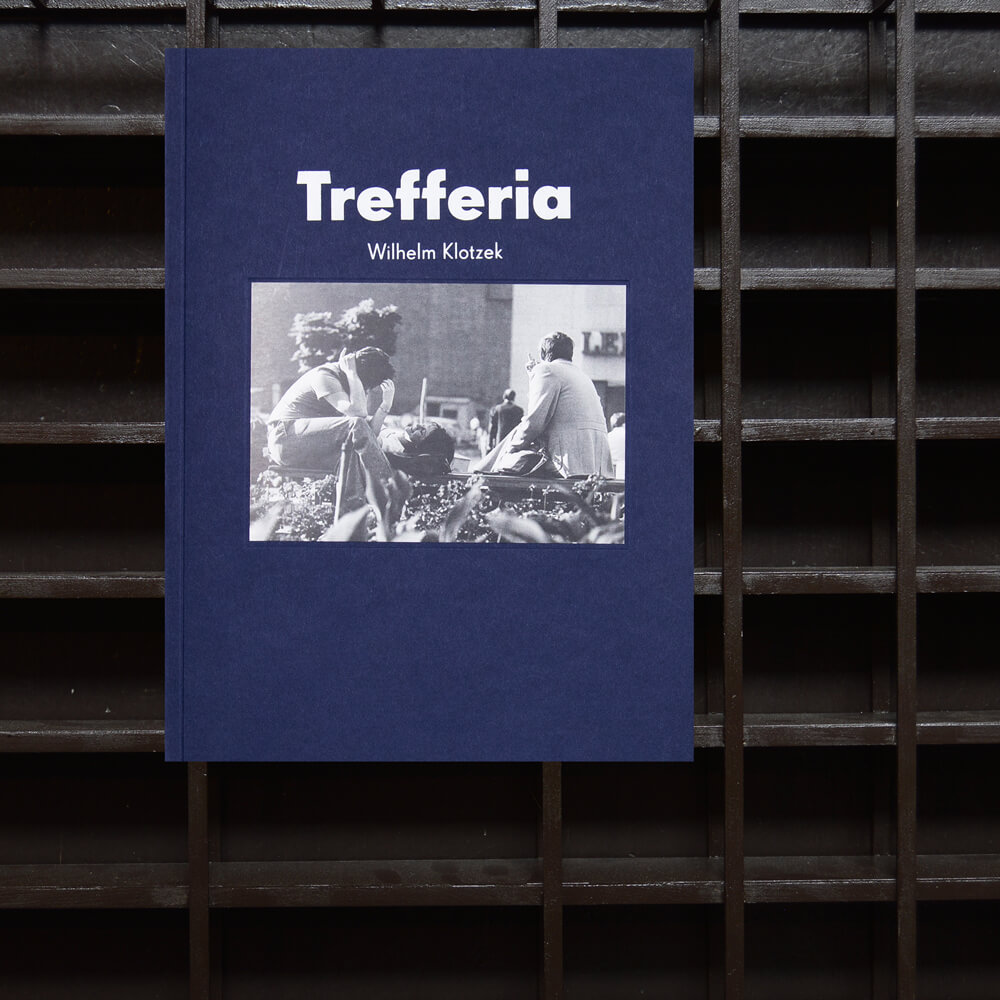
Trefferia – a made up word – mixing the words Treff and Cafeteria together. Appropriated from a cafeteria-like meeting place with filter coffee, beer and cold smoke. For Wilhelm Klotzek an ideal place to invite his own works to. Central to this book is Klotzek’s personal relationship with the medium of language. He embeds his body of works of the last ten years around his personal stories – growing up in East Berlin, going through his adolescence in the years of the post-fall-of-the-wall years. In sculpting his memories in dense moving texts that take us into the corners of the broken German past his dark and humorous approach creates a specific aesthetic language that he stretches and bends in various directions. Therefore Klotzek doesn’t only act as a sculptor of words, objects, memories and situations but furthermore also as a performer, display and furniture designer and collaborator when he works with his artist’s colleagues Konrad Mühe or David Polzin. ↑ ↓ ↓
€26,00
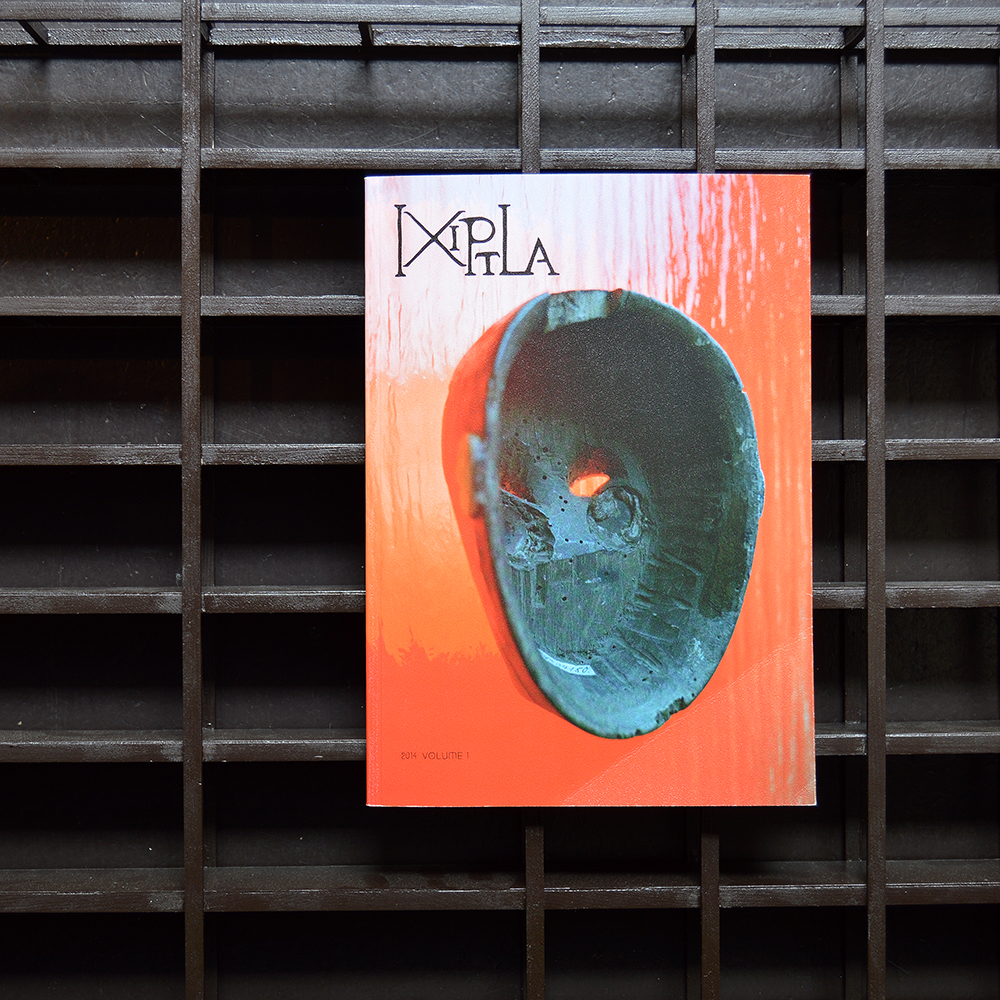
Ixiptla Volume I was published on the occasion of Expedite Expression, 8th Berlin Biennale for Contemporary Art in 2014. For this first issue, a group of anthropologists, archaeologists, artists, and writers have been invited to reflect on the role of the model, the copy, and reproduction in their areas of research and practice. This edition is focused on objects collected and produced by archeologists in an attempt to capture and replicate material evidences left by time. ↑ ↓ ↓
€19,00
SOLD OUT

Can we read an archaeological site through chance operations? Probably a different idea of time would evolve from this methodology. Feathered Changes, Serpent Disappearances explores the tension between indeterminacy and narrative in archaeology and art. On one hand, there is an attempt to record traces from the past in order to build up a coherent picture. On the other, we have a more schizophrenic way of dealing with memory, acknowledging ghosts, double visions, and multiple versions of history. ↑ ↓ ↓
€19,00
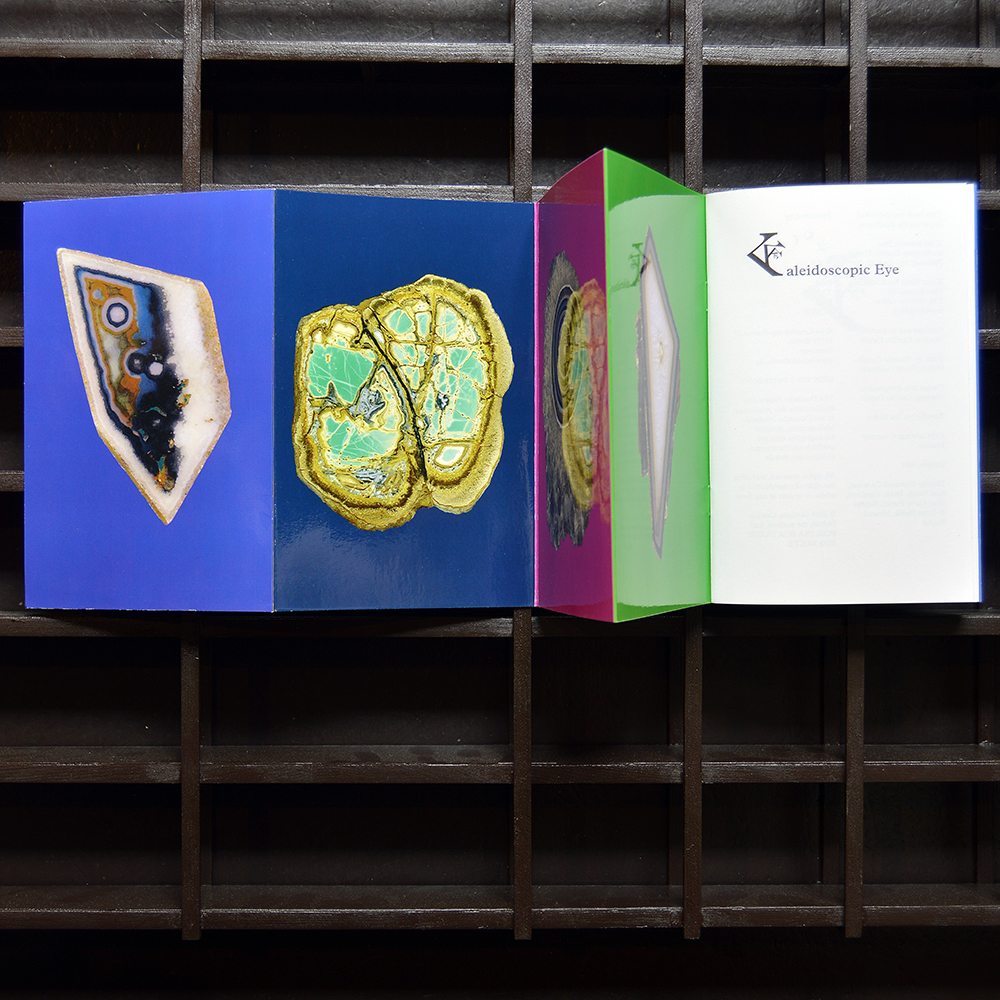
Kaleidoscopic Eye departs from an argument between André Breton and Roger Caillois. The confrontation arose from their discovery of Mexican jumping beans—beans that make sudden movements and leap into the air. Caillois conjectured that larva or some other animal was making the beans move. Breton rejected his theory, accusing Caillois of being a closed-minded positivist who negated the marvellous and the poetic in his attempt to find a rational explanation. For Breton, absolute or objective chance blurred the borders of rationality, proffering a chaotic and stimulating universe: convulsive beauty. Caillois wrote a letter ending the relationship with Breton, declaring his attempt to reconcile research with beauty. Caillois sought to examine chance, chaos, and the irrational with the goal of finding a pattern similar to the structure of coral. T his structure should combine, in one system, everything that had until then been systematically excluded—a structure capable of taking into consideration all the possible forms of reality. Kaleidoscopic Eye was first published as part of the exhibition Kaleidoscopic Eye, in 2009 at Kunst Halle Sankt Gallen, now republished in its second edition. ↑ ↓ ↓
€24,00
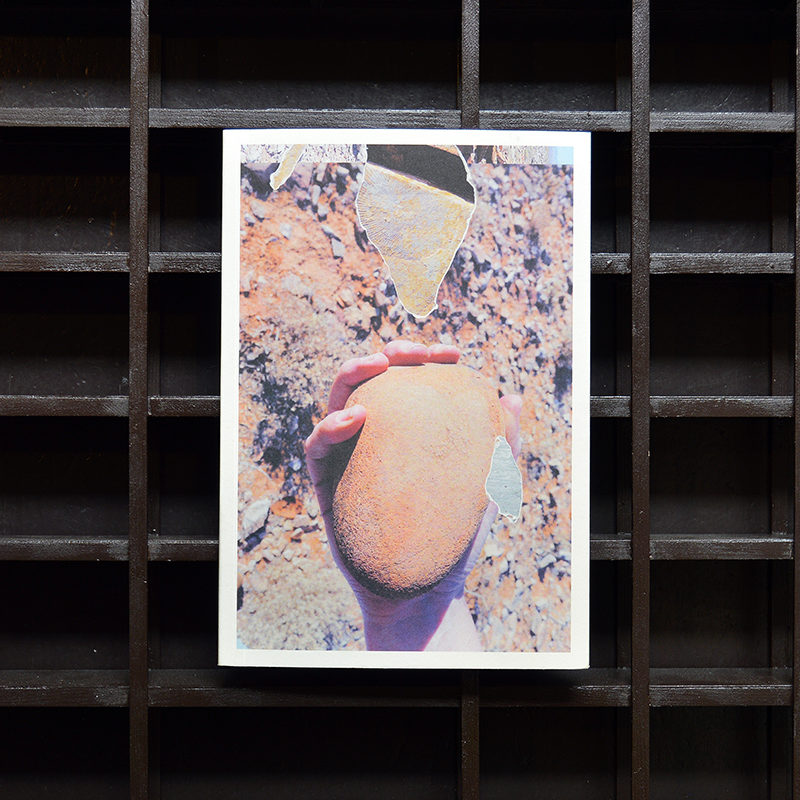
Replaying Life’s Tape explores a cycle of recent projects by the Berlin and Mexico City based artist Mariana Castillo Deball that take fossils and evolutionary trees as their subject matter, and departs from a research trip that she made to a significant fossil site in the Ediacara Hills of South Australia in 2018. Replaying Life’s Tape is also the first Australian exhibition of Mariana Castillo Deball at the Monash University Museum of Art, Melbourne (5 Oct – 7 Dec 2019). In this solo show, Castillo Deball presents a material and virtual recreation of the paleoecology of the Ediacaran Period, combining objects, sculptural display systems and viewing technologies to consider the relationships between site, time and history. ↑ ↓ ↓
€30,00
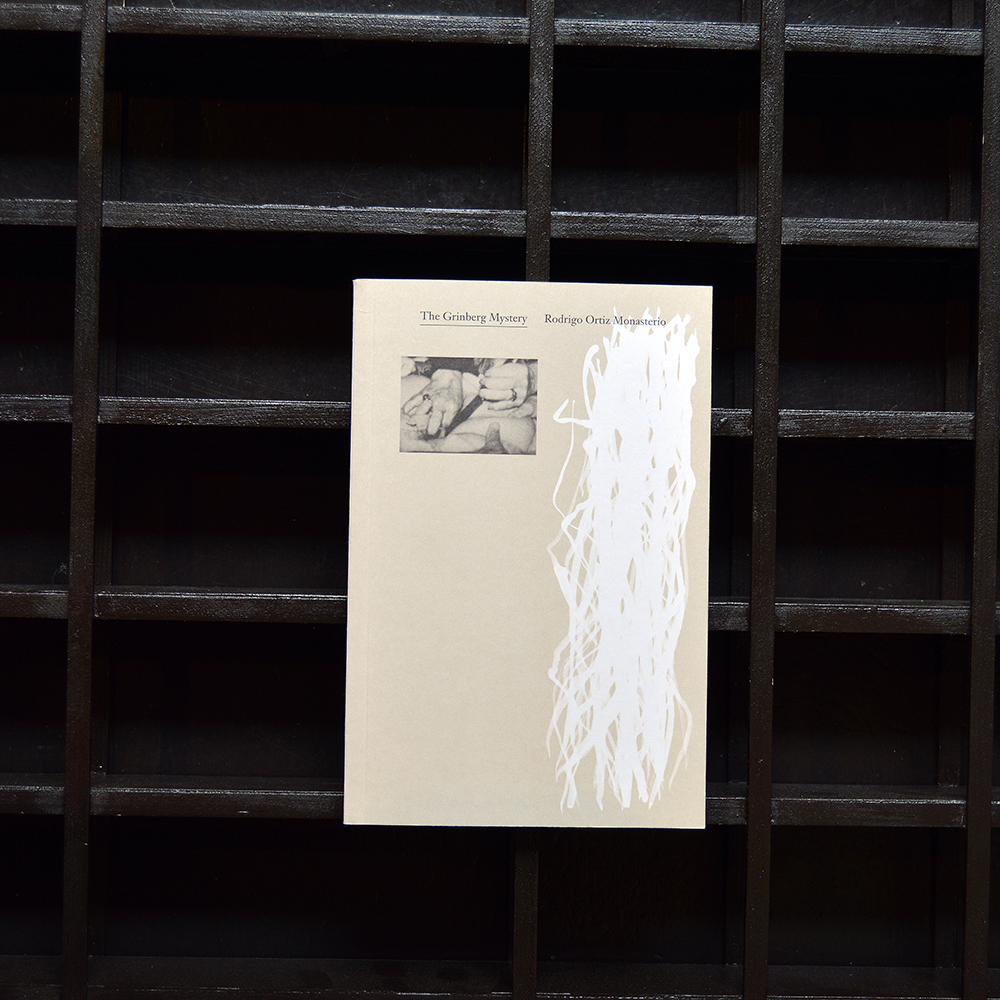
The Grinberg Mystery is a novel based on the author’s involvement with a shaman known as Brother Cuauhtémoc. It describes the author’s desperation, and his quest into the unknown searching for a cure, after his mother was diagnosed with terminal cancer. The book revolves around the limits of one capacity of doing anything for love, and that which lies in between the visible and the invisible. It is a story about acceptance, and learning how to let go of those who we love the most. ↑ ↓ ↓
€18,00

Started in 1998, the 'Lichtzwang' series consists today of more than 300 watercolors, all on 15 x 21 cm sheets of graph paper. Most works in the series are made up of groups of several watercolors wherein each successive work is a variation of the previous, showing a transformation. The last watercolor usually matches the first one, so that each group forms a loop that could be installed in any order. The process of realization is, however, guided by simple rules (play with the grid on the sheet, each item that appears in the watercolor lasts for three sheets), rules that bind while allowing improvisation and the introduction of a certain randomness in the process. These watercolors have the generic title 'Lichtzwang' (lightduress or lightconstraint) which in turn is the title of a book of poems by Paul Celan. ↑ ↓ ↓
€29,00
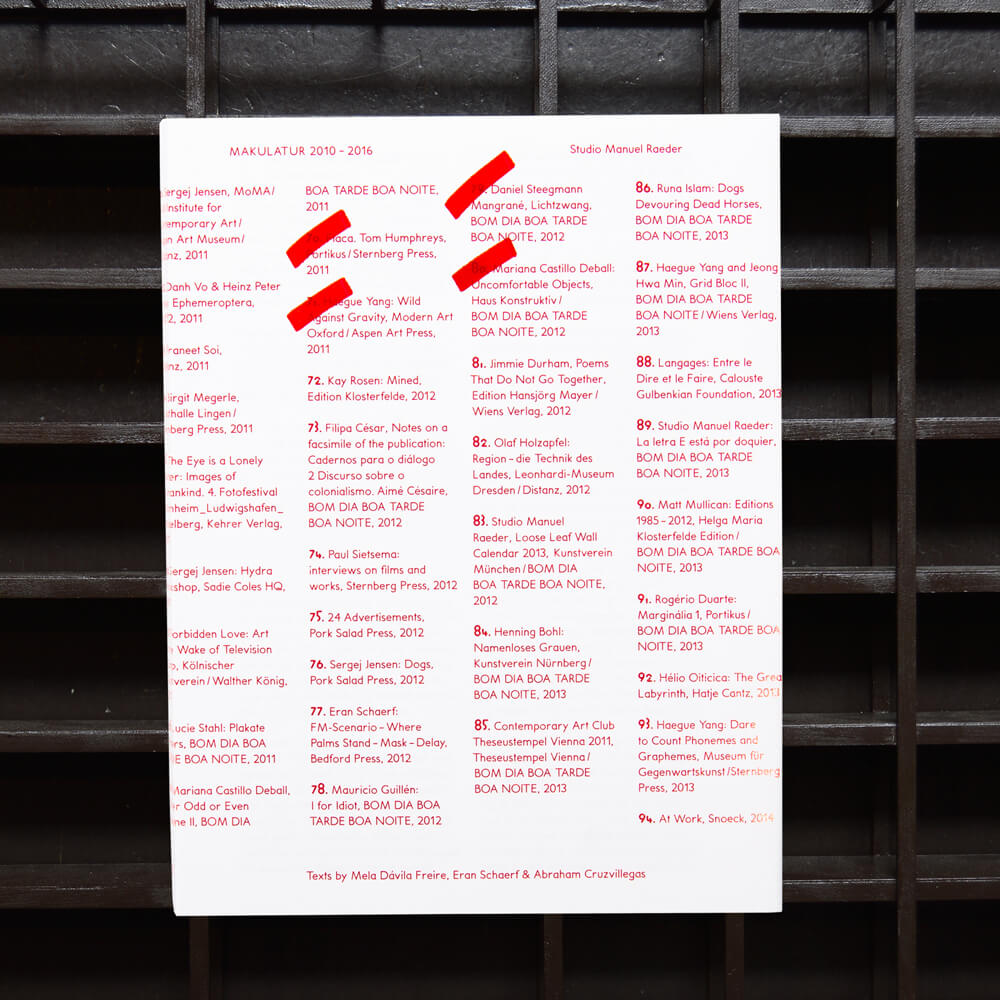
Makulatur, a German word that derives from lat. maculatura ’something stained’, refers to misprinted paper that is discarded at the beginning of the printing process as use- and worthless. In 2010, the graphic designer Manuel Raeder started to collect and preserve misprinted sheets of all the publications he designed not only for his own publishing house BOM DIA BOA TARDE BOA NOITE but also for fellow artists and institutions. These original waste paper sheets, with different qualities and grammatures, – trails, testy or stains – were combined to a new volume as a compilation of maculae ’stains’. Thus, dissolving the spoiled material from the realm of invisibility and displays it to the public whereby the Makulatur book reveals and reflects on the conventions of a book. ↑ ↓ ↓
€34,00
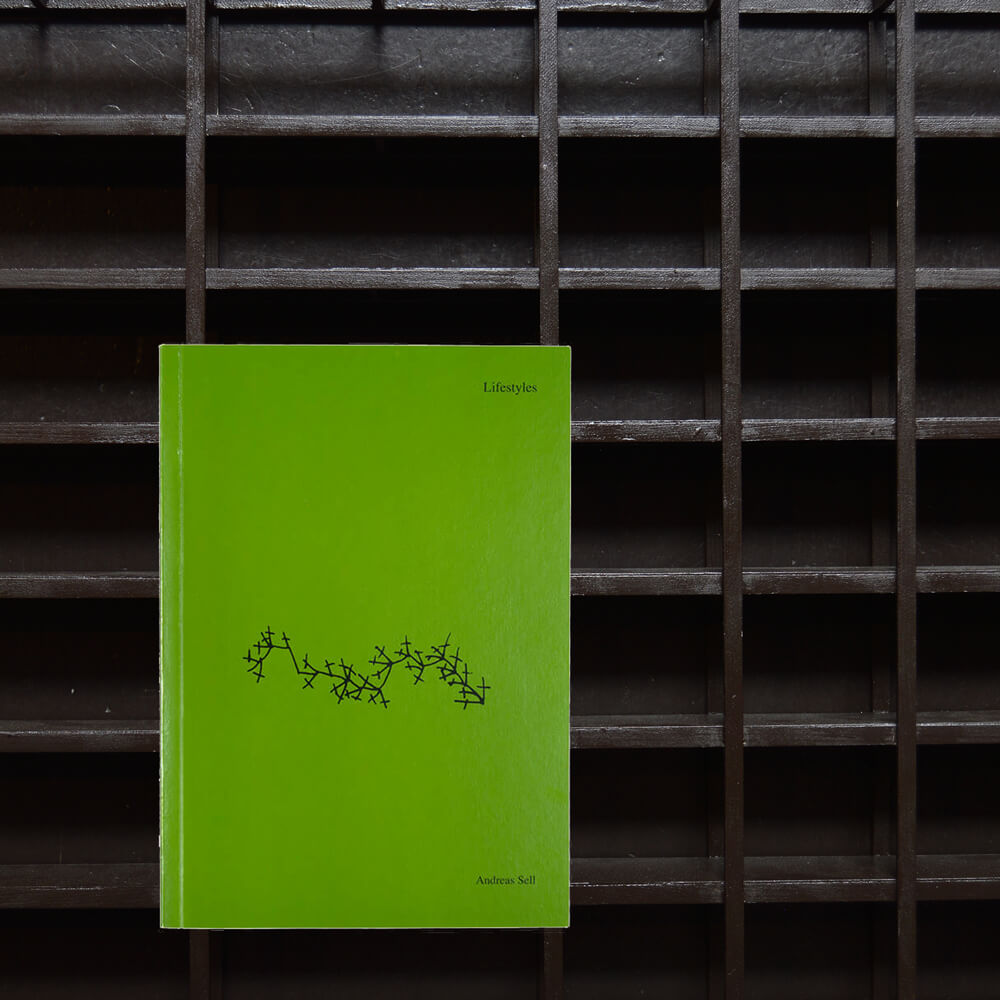
In Lifestyles Andreas Sell combines a diary with photographic documentation, pictures of sculptures and drawings from 2010 to 2015. These excerpts reflect his nomadic-like life, the clearance of his parents’ household and the enterprise of building a holiday house. Andreas Sell’s artistic process reveals a strategic method within the conventions of our capitalist society, which are simultaneously subject to critical analysis. A question discussed since the 1960s is a recurrent theme: Where does the private sphere cross over into the public sphere? Over the last years, Sell worked on the founding and operation of an employment agency, the documentation and sorting of his property, living without a permanent residence and travelling to the Sahara without mission or goal. The book co-constitutes together with the holiday house on the island of Lesbos the making of an art work. ↑ ↓ ↓
€17,00
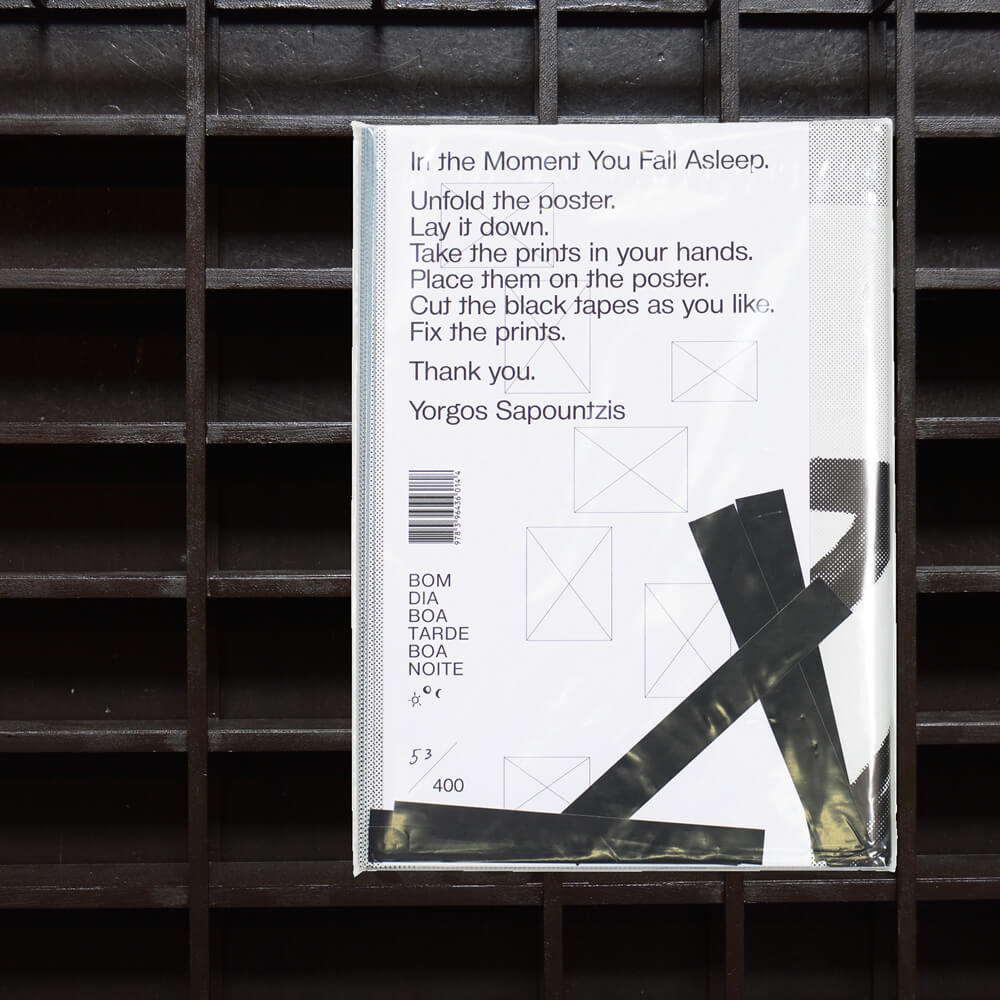
€26,00
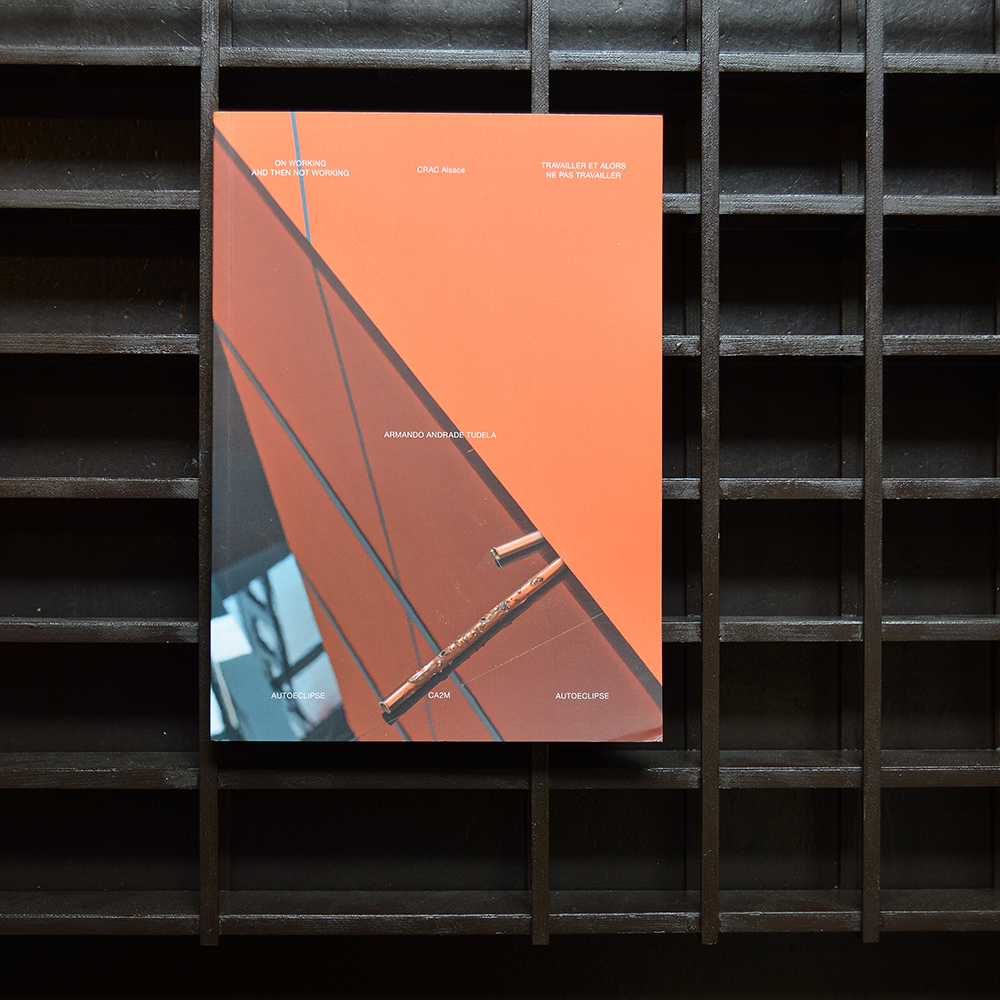
On Working And Then Not Working / Autoeclipse is published on the occasion of two solo shows by the artist Armando Andrade Tudela: On Working And Then Not Working at CRAC Alsace, France (June 14–September 16, 2018) and Autoeclipse at Centro de Arte Dos de Mayo, Spain (February 24–September 15, 2019). An in-between space between the exhibitions, the catalogue features extensive documentation accompanied by collages of the artist’s evolving works as well as new essays by the show’s curators, Elfi Turpin and Daniel Steegmann Mangrané. ↑ ↓ ↓
€24,00

En algún lado y en ninguno is a compilation of poems by the jazz musician and poet Sun Ra (Alabama 1914 – Birmingham 1993), selected and translated into Spanish by Mariana Castillo Deball, Tania Islas Weinstein and Alberto Ortega. The adventure began in a library that looks like a spaceship, next to a monument in the shape of a burned marshmallow that celebrates the first atomic reaction generated by humans. A plaque in the monument suggests that the powerful energy should be used for beneficial purposes. Inside this lunar library is the Special Collections Centre at the University of Chicago, that keeps the archive of Alton Abraham – Sun Ra Collection, comprising the period 1822-2008. Alton Abraham (1927-1999), entrepreneur and hospital technician, was a friend and partner of Sun Ra, and throughout his life he collected manuscripts, ephemera, artifacts, photographs and audio-visual recordings of the work of Sun Ra and his collaborators. Within the archive, which occupies 48 m of linear shelf space (146 boxes and a large folder) we found Sun Ra’s wallet, containing his lawyer’s business card, the insurance receipt for his car, a cabalistic amulet, and a million dollar bill perforated in the center. We also discovered Sun Ra’s typed poems, with handwritten corrections and in various versions. His poems generate a parallel geometry, a world that is precise and ambiguous at the same time. A sidereal enthusiasm made us think that the translation of his poems into our mother tongue could bring us close to his cosmos, and simultaneously allow us to share them with the Spanish-speaking firmament. Selection and translation by Mariana Castillo Deball, Tania Islas Weinstein and Alberto Ortega. ↑ ↓ ↓
€20,00
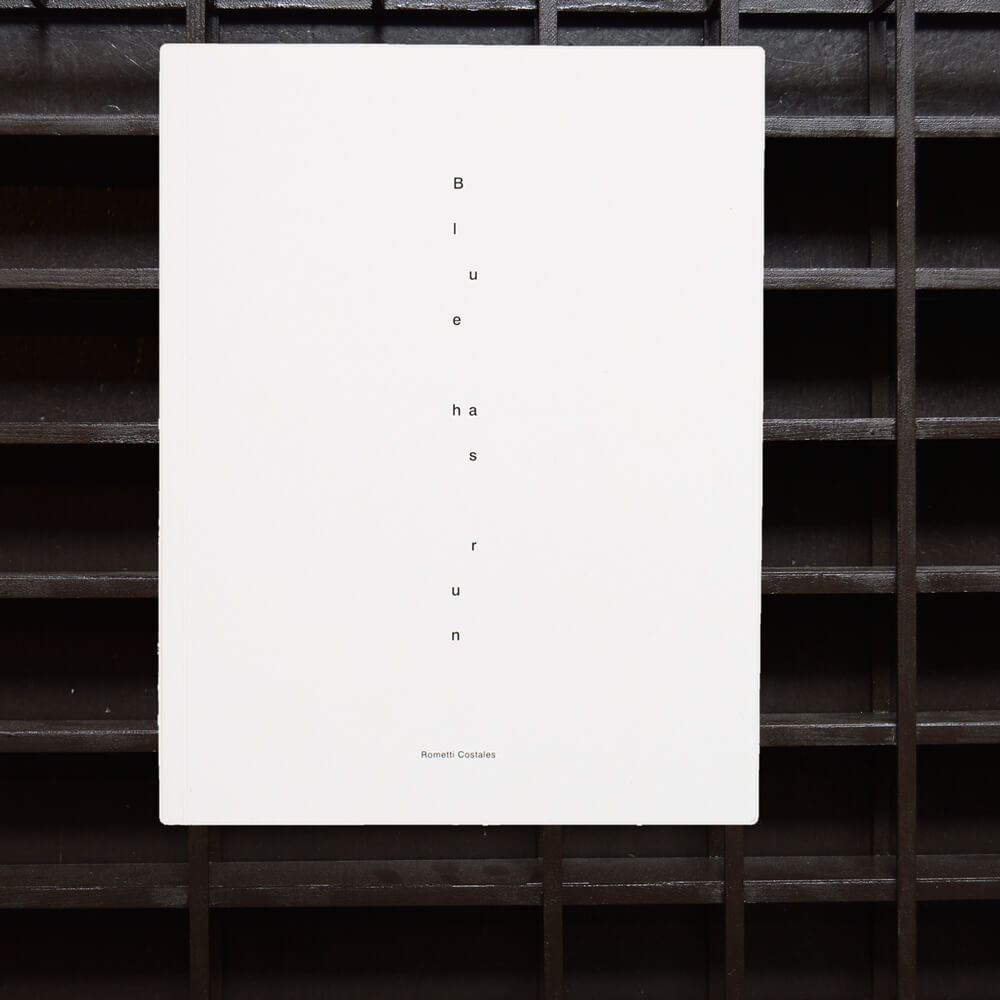
Blue has run is an intervened facsimile of A Catalog of Textiles and Folkart of Chiapas by the anthropologist Walter F. Morris, published in 1979. The original publication was printed in 100 copies, most of which have been lost or dispersed through various specialized libraries. This catalog listed the items belonging to three collections of fabrics and weaving patterns in South Mexico which Walter F. Morris, called Chip, helped to constitute during mid seventies: the Pellizzi, the Pomar and the Morris Collection. Its DIY quality gives the images an almost abstract twist. This and the painstakingly precise descriptions of the items take the content of the catalog towards territories closer to poetry, drifting it away from its original purpose. ↑ ↓ ↓
€28,00



